The Jakarta weddings are different than the Batak weddings for example. The wedding ceremony is different, and of course the wedding dress. The Jakarta wedding dress is easily recognized.
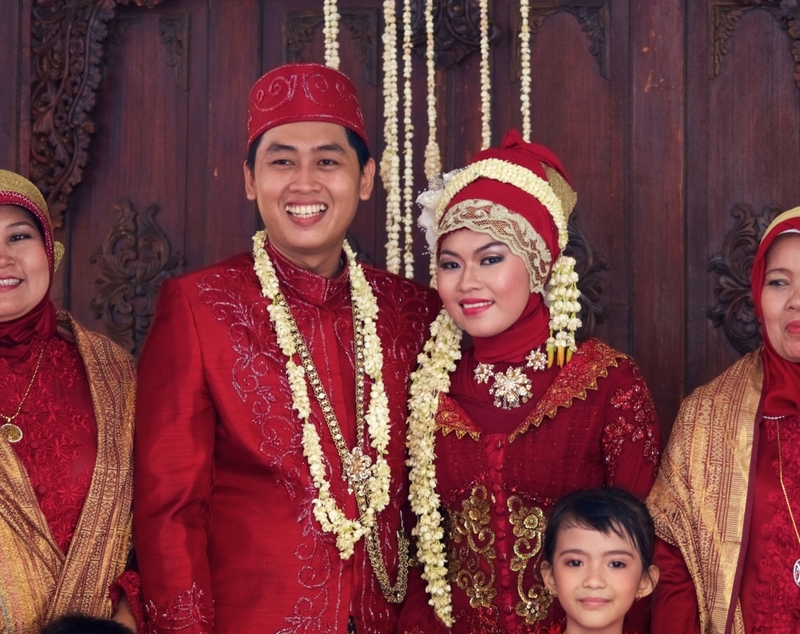
It is covered in golden ornaments embroidered patterns, usually in shades of red and marron.
Fiji
The Fijian bride is escorted to her groom via Bili Bili, a boat with a wedding throne. She wears a flower garland of tapa cloth strung with colorful native island flowers and she wears a traditional masi dress, also made of tapa.
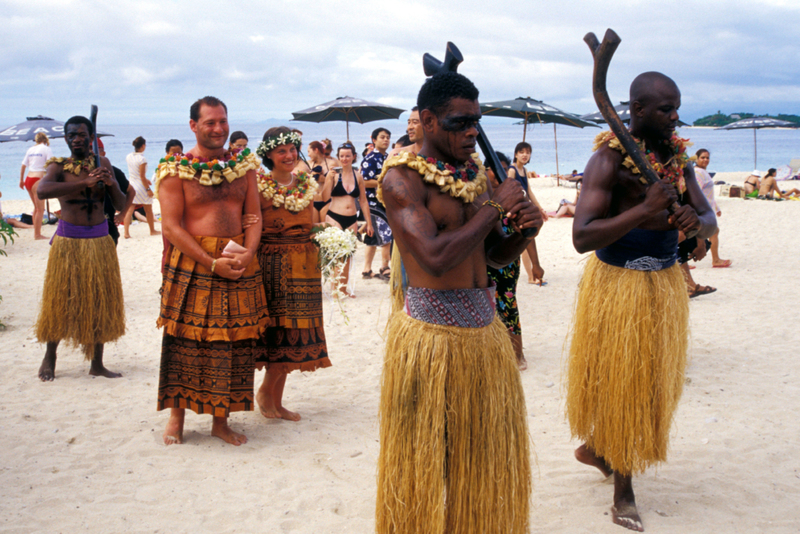
Tapa fabric is derived from the bark from the Fijian mulberry tree which is wetted and pounded onto a flat surface. It is dried and becomes tapa fabric. Fijian patterns are painted on the fabric before it is made into a dress.
Peru
In Peru, women are decked out in culturally significant, brightly colorful patterns on their wedding day. The special garment, called a pollera, consists of a handwoven multi-layered skirt. A bride may wear as many as 10 layers. The vibrant patterns and colors symbolize her Incan heritage. Perhaps most noticeable of all is her headdress, except that the hat, called a montera, is also worn by the groom in matching styles.
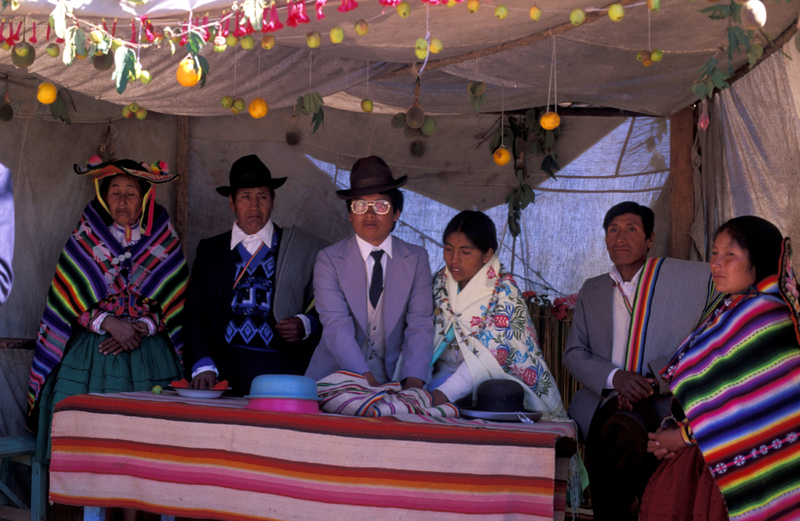
The bride and groom wear coordinating jackets as well — they are called jobonas and look like sequined woolen ponchos.
Bangladesh
Bengali brides are adorned in red and gold. They wear a customary saree, a long cloth that is draped around her as ancient traditions call for. It is lavishly embroidered in gold, likewise, gold lavishes the bride. Loads of jewelry, a bridal tiara or crown, and a Nolok (a large round nose ring) or Nath add to her adornment.
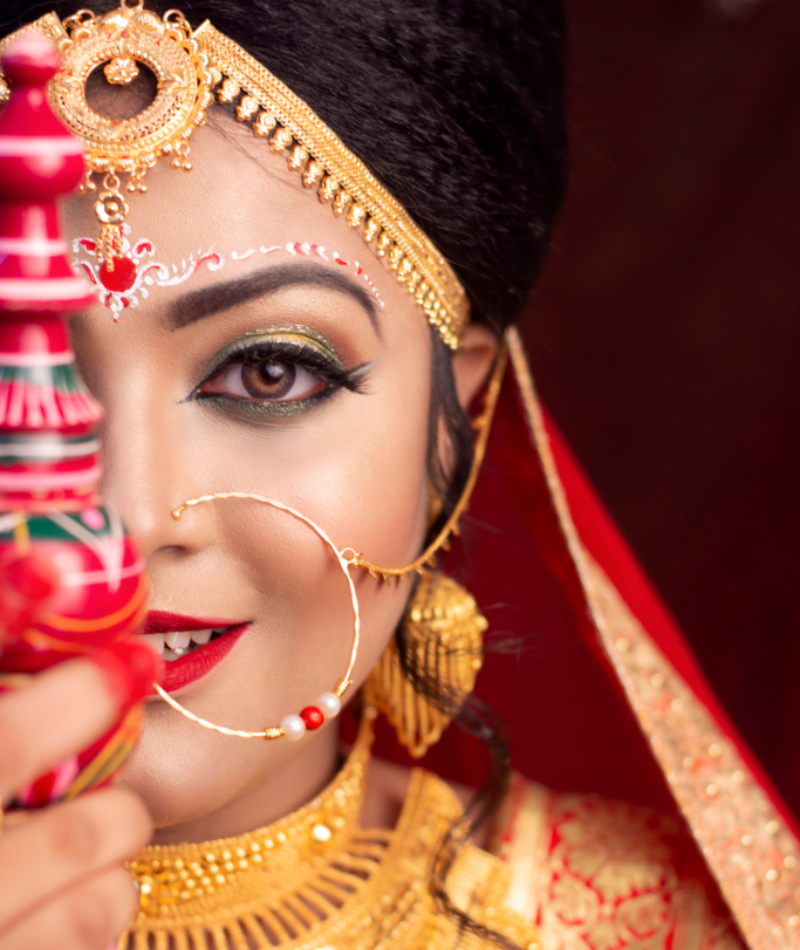
Traditional jewelry on her forehead keeps the veil in place as well as adds to the stunning look. Hands and wrists are decorated in henna.
Poland
Modern Polish brides have adopted the western-style white gown. But earlier in their tradition, dresses of any color were worn, usually their best one. An important element of the bride’s dress is a special veil. A unique ceremony called an Oczepiny, in which the bride is unveiled, is a very old Polish tradition that includes throwing the veil to a gathering of unmarried women and having her maidenly braids sheared off.
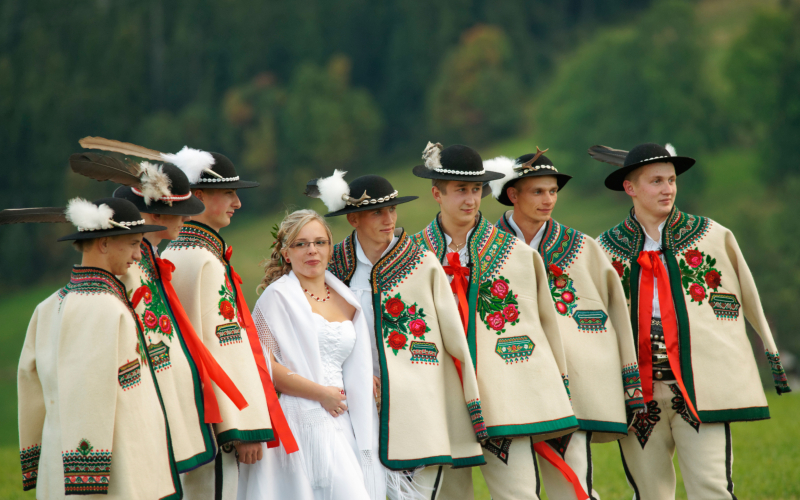
It usually happens around midnight culminating in a long and festive reception party.
Pakistan
Pakistani wedding dresses are bold and vibrant, exquisitely adorned, and immersed in history. Influences from the Muslim world and India come together in Pakistan to bring a unique tradition. Pakistan is Islamic, for example, yet the bride partakes in henna painting on her hands.
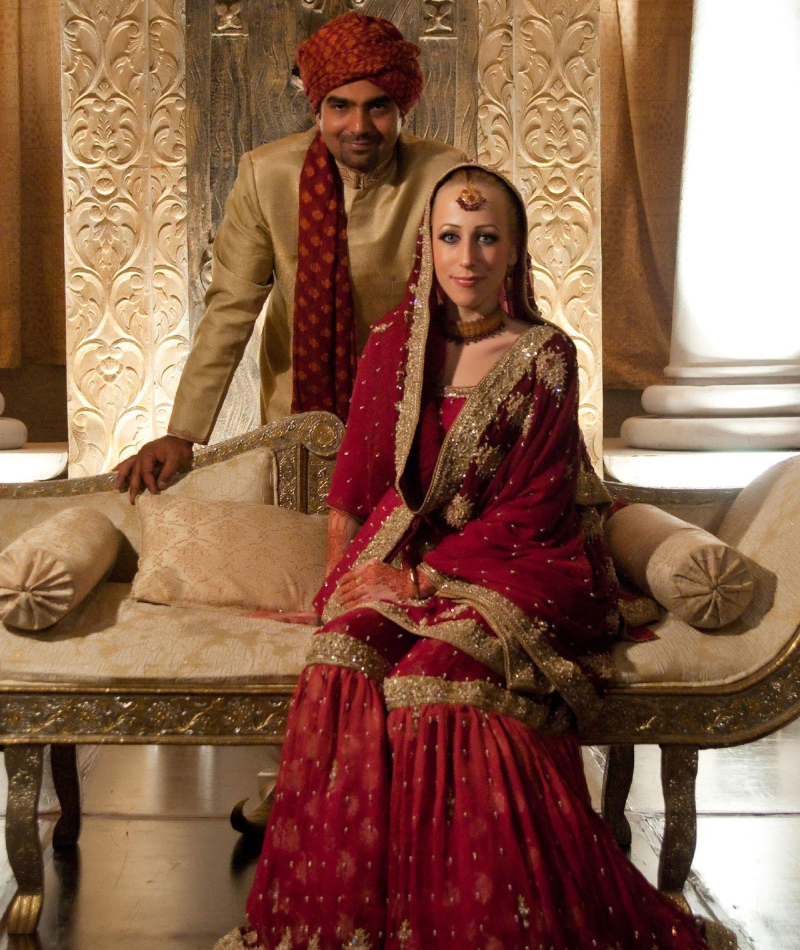
Several beautiful styles of Pakistani dresses are worn by the bride, but the shalwar kameez is most common.
Southern Cheyenne
Native American tribes all have different styles of wedding attire. In the Southern Cheyenne Tribe of Oklahoma, the bride wears a buckskin dress. It is white and made of the lightest deer and elk hide available. The Southern Cheyenne bride’s dress is intricately beaded with white, red, yellow, and black, representing the people of the world. At the hem are curves and cones.
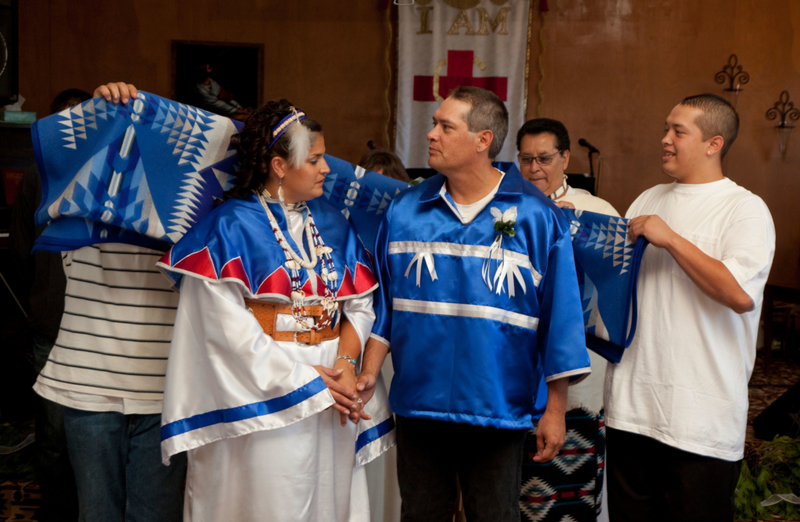
The curves represent the mountains and the metal cones are there to ward off bad spirits. A Cheyenne buckskin dress is laborious, and one can cost up to $10,000.
Sami
The Sami are Scandinavia’s indigenous people. They live in the northernmost parts of Europe. Their culture spans the area in Norway, Sweden, and Finland and dates back centuries. The local wedding dress, called a Kolt or Gakti, is colorful and festive.
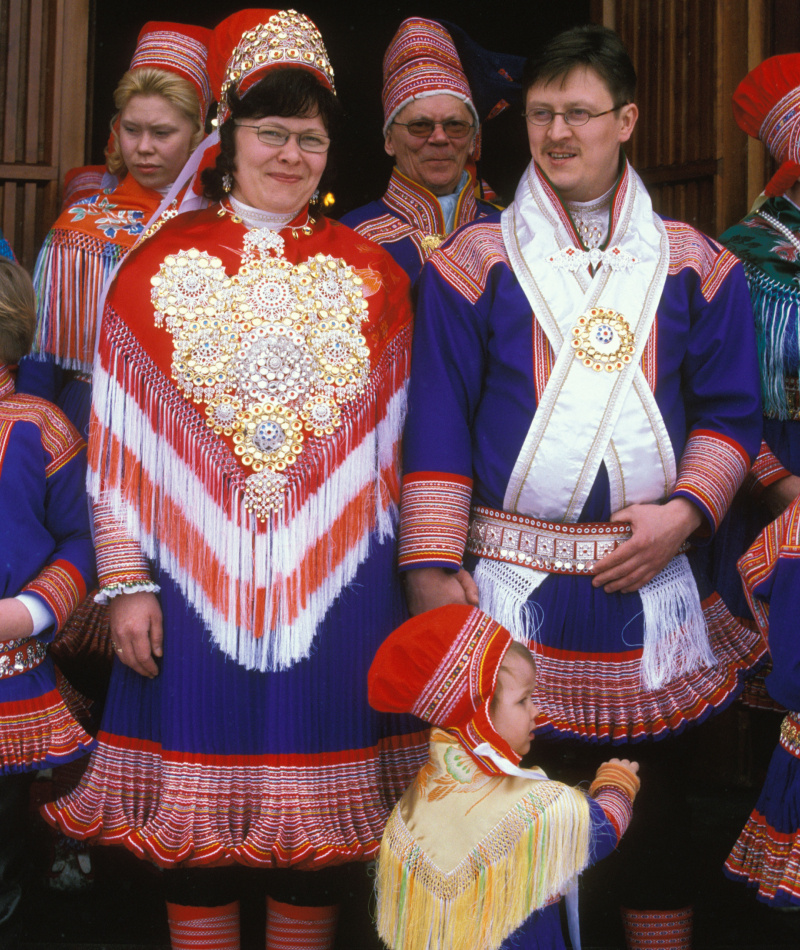
Blues and reds dominate the looks and the bride wears a bejeweled brooch which can be very large. It is decorated with curved baubles that reflect the light.
Turkmenistan
The Turkmen bride is usually in red, her dress made of homespun silk. The dress is embroidered from head to toe and adorned with silver or gold pendants. A red piece of cloth over the bride’s mouth is a unique custom and serves as a symbol of her piety. As a part of the symbolism, she is expected to be silent and not allowed to speak to the groom during the ceremony.
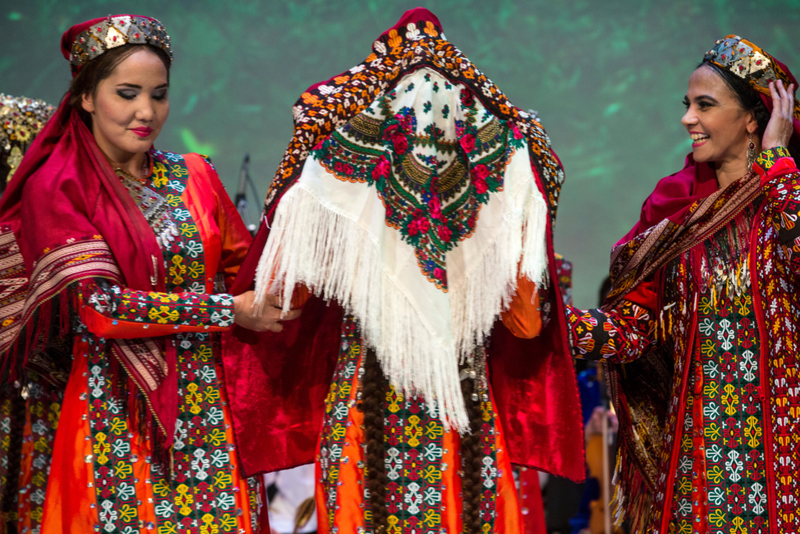
She is also prohibited from making eye contact with guests and therefore averts her gaze toward the floor.
Kazakhstan
Kazakh brides wear a headpiece called a Saukele. It’s a beautifully adorned pointed headdress decorated with gems, precious metals and stones, pearls, and owl feathers. It’s arguably the most significant part of her look, and certainly the most expensive. Traditional dresses in a Kazakh wedding are red and paired with a scarf usually given to the bride by the groom’s mother.
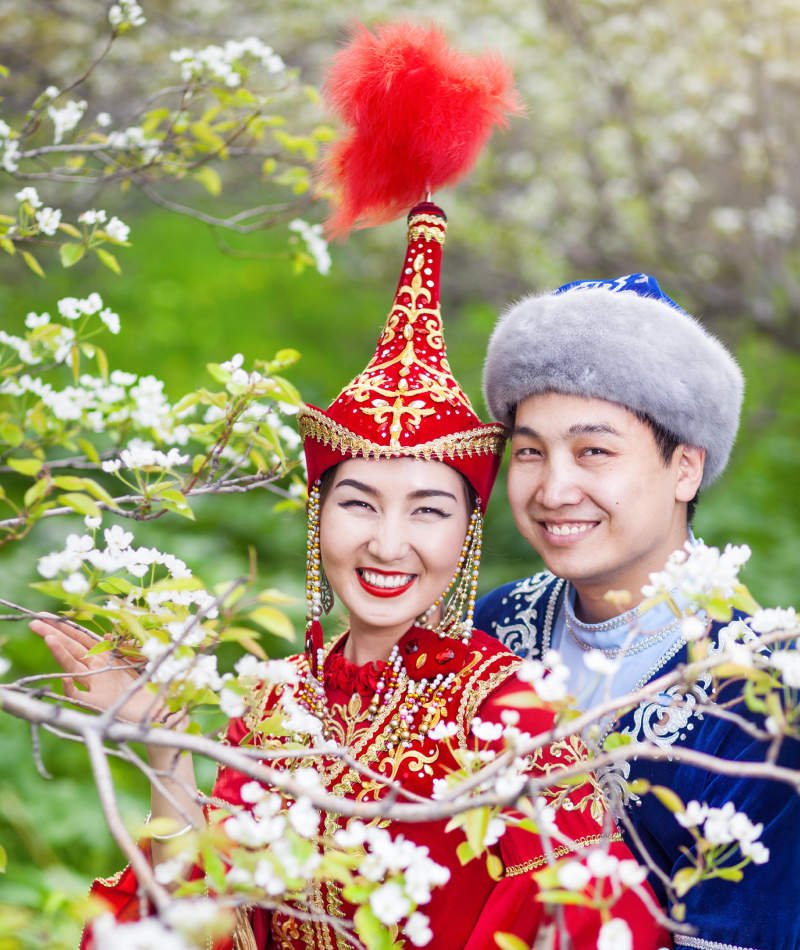
The Saukele is also veiled and is customarily is made years before marriage. As a Saukele might be worth as much as a herd of horses, it is a status symbol.
Hungary
Traditionally, the Hungarian bride is dressed in a multicolored gown embroidered with floral designs. Several skirts underneath fill the dress out for a voluminous effect that is balanced with an elaborate headdress. It is very large and heavy and it dwarf’s the bride’s face, but also makes her bridely presence unignorable.
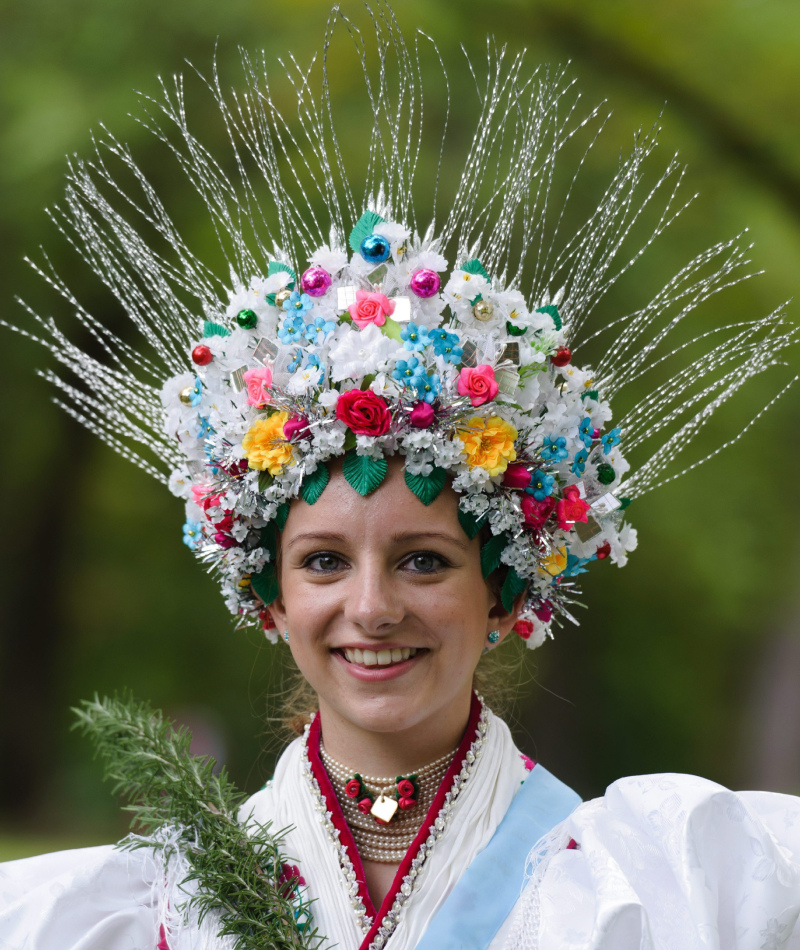
Old traditions have wheat woven into it as well as ribbons, artificial flowers, baubles, and foil décor.
Nigeria
In Nigeria, there are three main tribes, Igbo, Hausa, and Yoruba. In a Yoruba traditional wedding, the bride wears an Iro and Buba, as they do in Ghana (also featured in this article). They also wear a decorative head wrap, a vibrant veil, and a shoulder scarf.
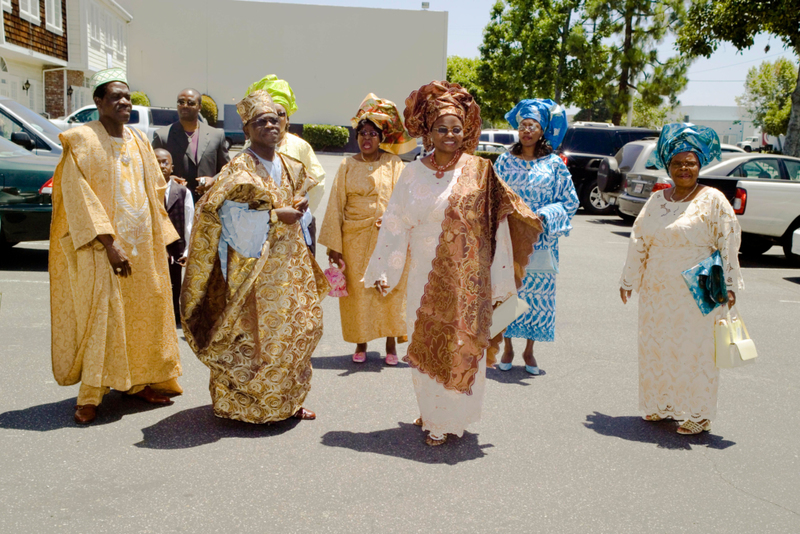
In the Igbo tribe, the bride wears various celebratory outfits with a crown and necklace of coral. Vibrant colors and family patterns make up the pair’s ensembles.
Iraq
Iraqi weddings span seven days, traditionally, and the bride wears a different gown for each day of the marital celebration. Her dresses are in seven different colors, corresponding to the primary seven colors. The number is culturally significant.
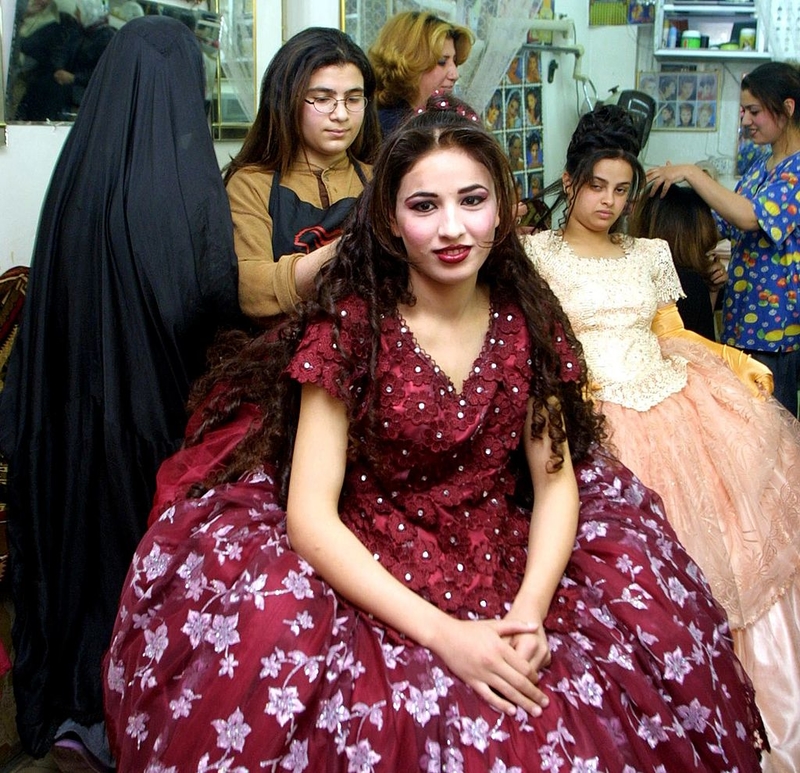
Henna is another bridal tradition — the bridesmaids adorn her hands and feet with intricate decorations the night before the wedding. The bride and groom are seated on a sofa called a kosha while the religious ceremonies are conducted.
Lebanon
A Lebanese bride is dressed in white, but the style varies from that of the typical white wedding. She wears a simple white hijab, though some choose a more ornate headcover. The floor-length dress has a high neck and long sleeves, leaving only the bride's face visible.
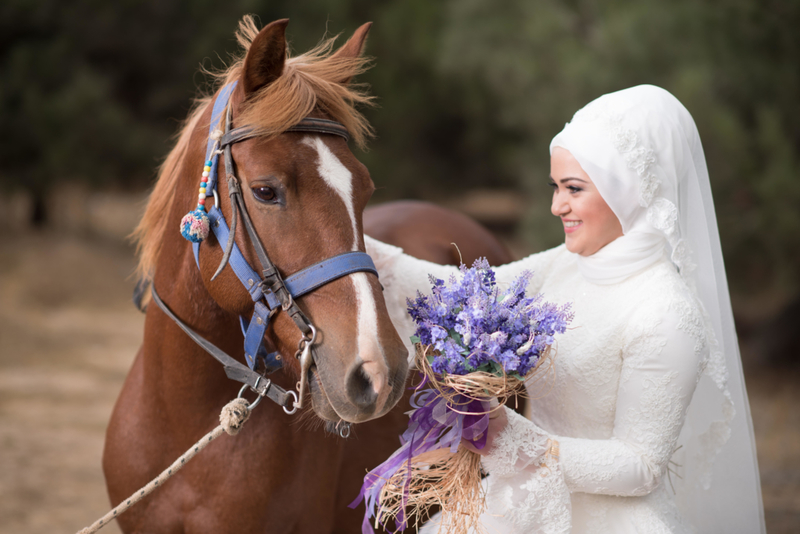
She wears plenty of gold jewelry passed down from the parents of the bride and groom. Lebanese weddings are festive affairs with up to 800 guests!
Nubia
The ancient kingdom of Nubia and its culture is located in Africa, along the Nile between Egypt and Sudan.
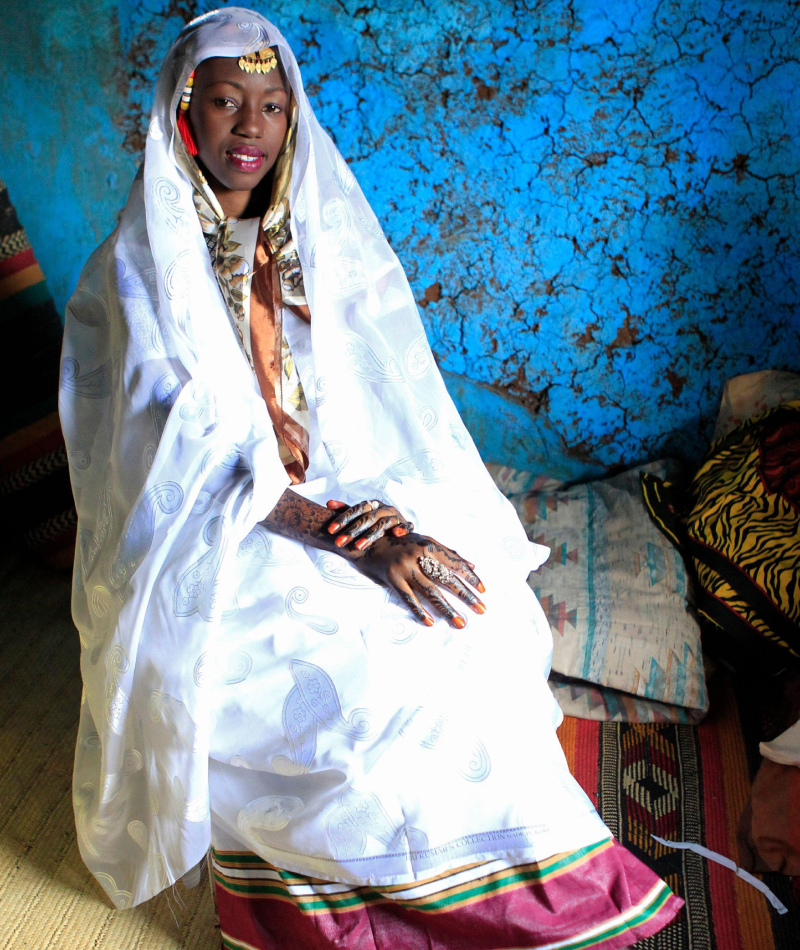
The bride from the Nubian culture has the unique custom of wearing no less than three bridal veils! First, a white sheet covers her face completely. Then there is a sheer white veil, and on top of that is a colored veil.
Iceland
Traditional marriage costuming in Iceland comes from Viking heritage, as Vikings originated from that area. The bride wore her hair down for the ceremony, which was one of the last times during her life it would be uncovered.
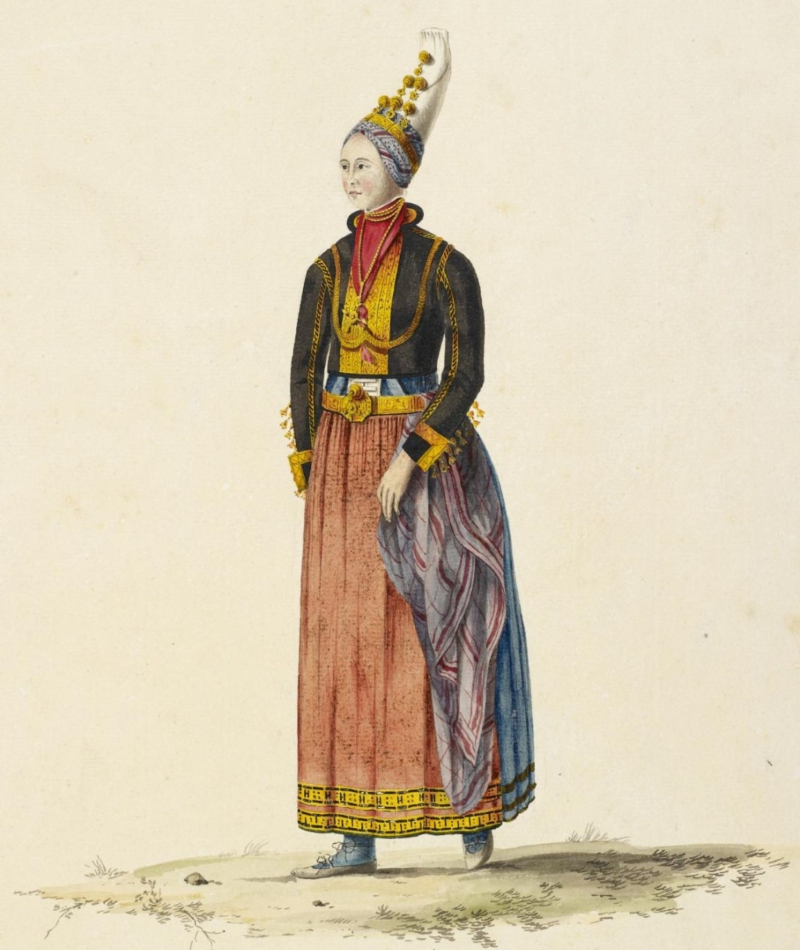
On her head sat the bridal crown which was generally a family heirloom. It was the most important element of the bride’s attire and might be bejeweled, made of precious metal, or decorated with silk cords.
Cambodia
A Cambodian bride can choose from a variety of colors. She usually wears an exquisitely beaded sarong in blue, yellow, or green. The garment is traditionally made of silk and the guests are expected to match it and dress in the color schemes chosen by the wedding party.
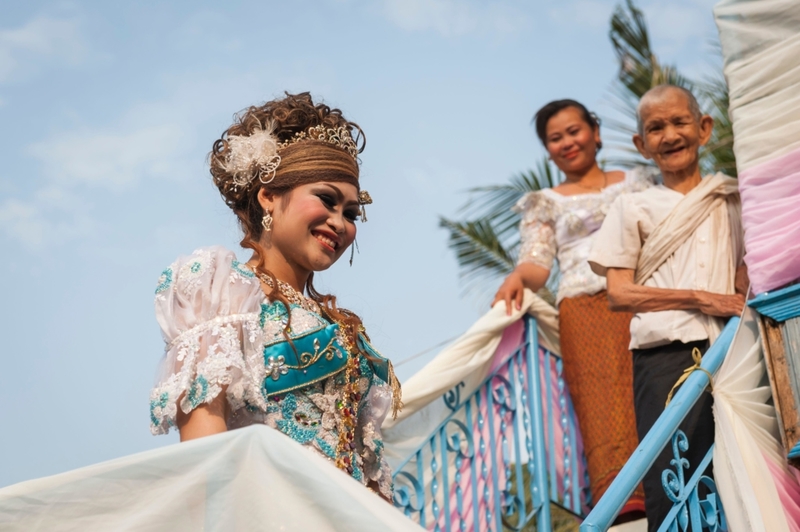
The ceremony continues for three days as the number is significant to Buddhism’s three jewels: Buddha, the Sangha, and the Dhamma.
Tunisia
A significant part of the bride’s ensemble is called a Kmejja. It is traditionally yellow and green and lavishly embroidered in silver, gold, sequins, and badla wire. The Kmejja is worn at the henna party, which is a central part of the Tunisian wedding tradition. Sleeves called jabda are added to the bridal dress following the henna party.
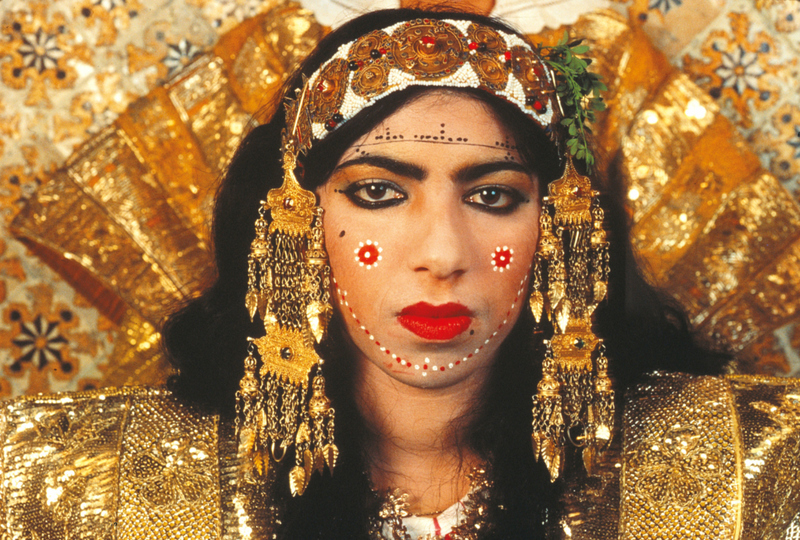
The bride wears a cap embroidered in the same golden material. Covering her face completely is the khtamra, made, likewise, with that stunning and lavish embroidery. The reveal of the bride to the groom happens the night before the wedding, which lasts up to a week.
Sumatra
In South Sumatra, traditional wedding costumes are called Aesan Gede. Made from the songket fabric and woven with jewels in metallic threads, brides look exquisitely beautiful wrapped in it. The dress is in shades of gold, red, and light pink as a representation of Sumatra’s ancient Srivijaya empire.
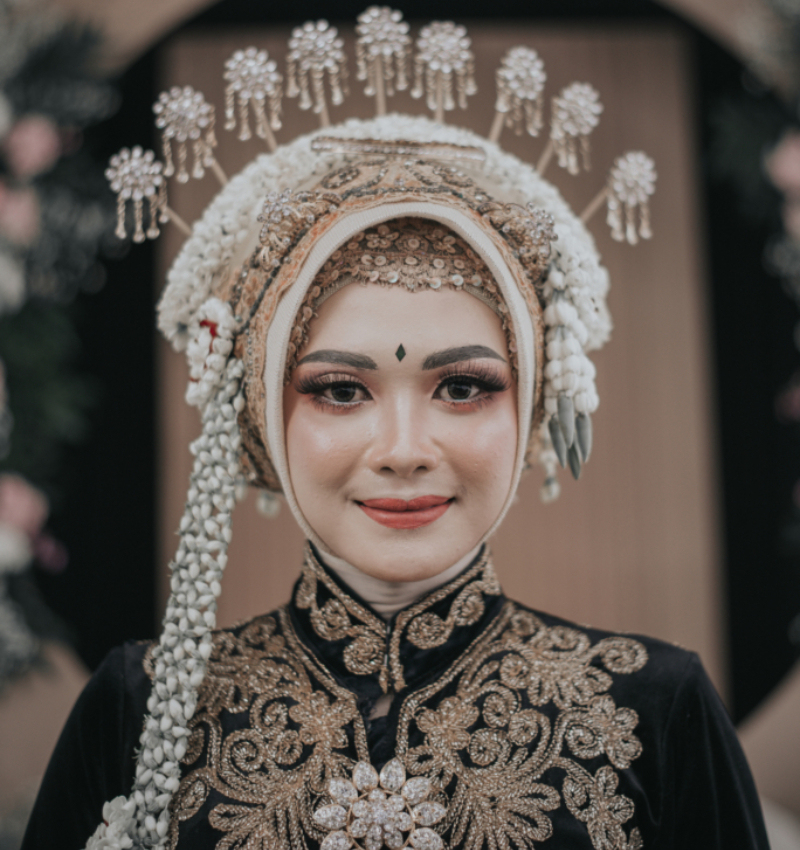
An elaborate headpiece crowns the bride. Not to be outdone, the groom is crowned complementarily.
Spain
One special item of the Spanish bride’s ensemble is a head covering called a mantilla which is traditionally embroidered and given to her by her mother. The dress and the mantilla are made of black lace and silk. The color is a symbolic nod to the part of the vows that says, “until death do us part.”
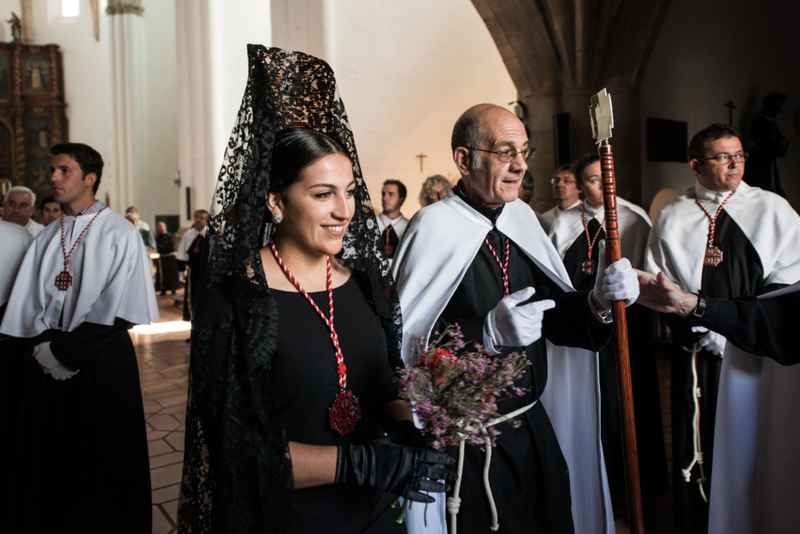
Wearing black is an old Spanish custom which most modern brides do not choose to observe.
Sri Lanka
The island nation off the tip of India is home to several ethnicities and hosts many Indian cultural influences. The Sinhalese make up the dominant ethnic representation in Sri Lanka. Sinhalese brides wear a long blouse, sometimes with puffy sleeves from the royal tradition, and a petticoat-style skirt.
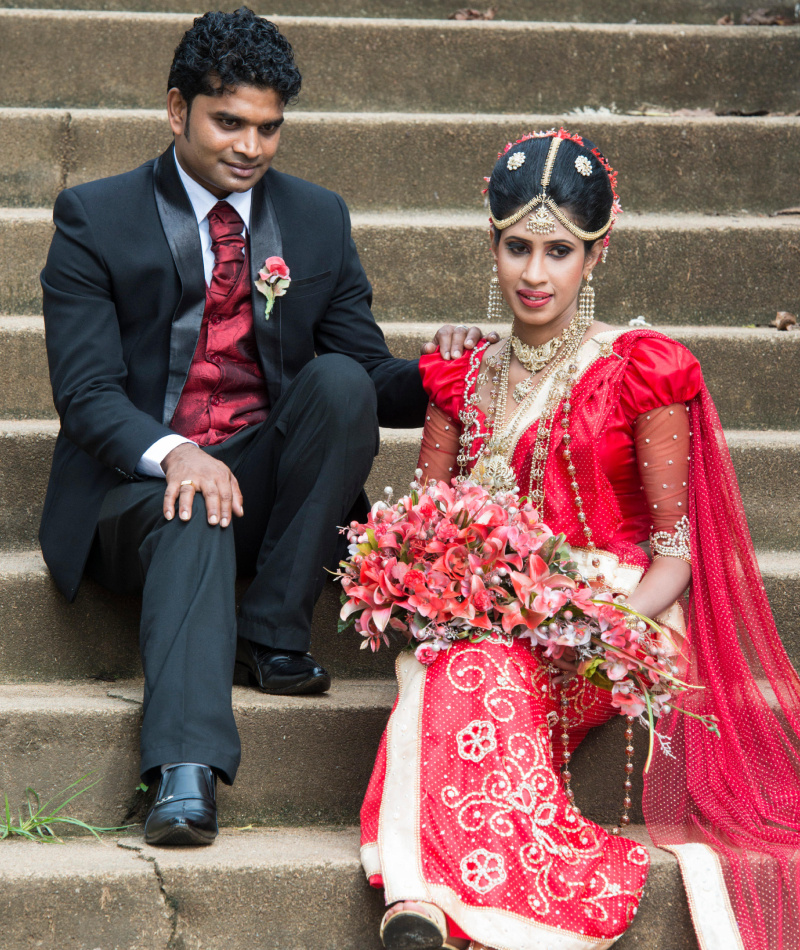
A distinctive part of the bride’s attire is a long, beautifully draped silk sari. The heavily embroidered silk cloth is weighed down with beads and sequins that are attached with gold and silver thread.
Morocco
The Moroccan bride wears an ornate traditional dress called a takchita. She is in this gown as she is being carried into the ceremony on an amariyah held by the groom and his family. It is a very old Moroccan custom, and it symbolizes support from her new family.
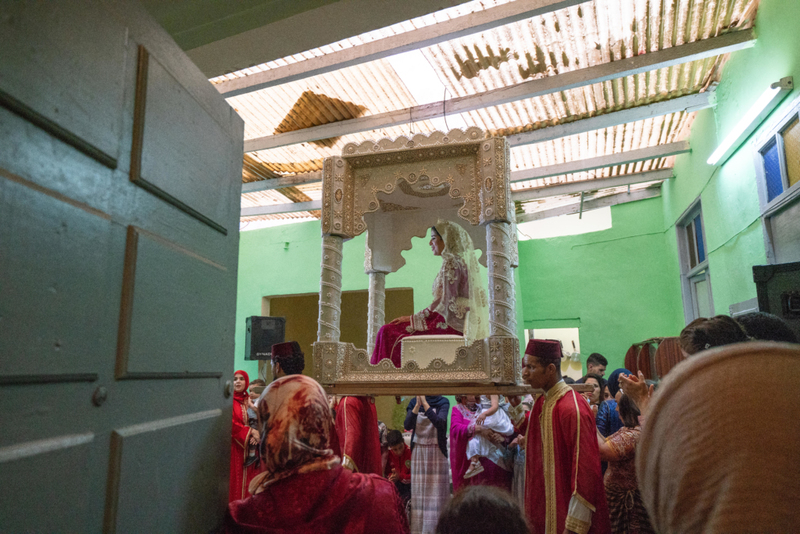
Her dress is often cream or white, but she wears many wedding dresses and festivities can go on for a week. Another traditional dress she wears during the celebration is called the Amazigh dress.
Turkey
A bride in Turkey may wear a traditional bindalli dress at the henna ceremony. The gorgeous velvet gowns, usually in deep reds, are embroidered in the bindalli style and have a long train and jacket. On the wedding night, she wears a traditional white gown.
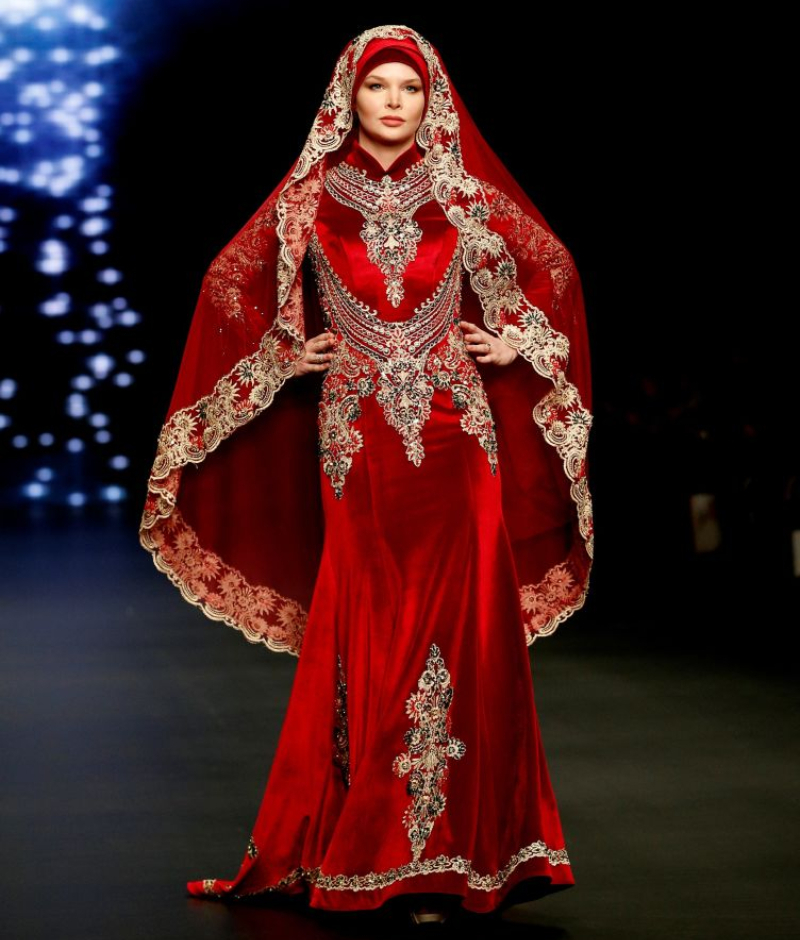
A red ribbon is tied around her waist in an old custom. The person tying it is a brother or other male relative that she is close with.
Bedouin
The Bedouin are a nomadic Arabic population that lives in the Middle East, North Africa, but primarily in the Arabian Peninsula. A traditional wedding will begin with the sacrifice of a camel. The bride’s costume is elaborately embroidered in a cross-stitch pattern. Design patterns are sewn across the front and back of her dress and along the main seams.
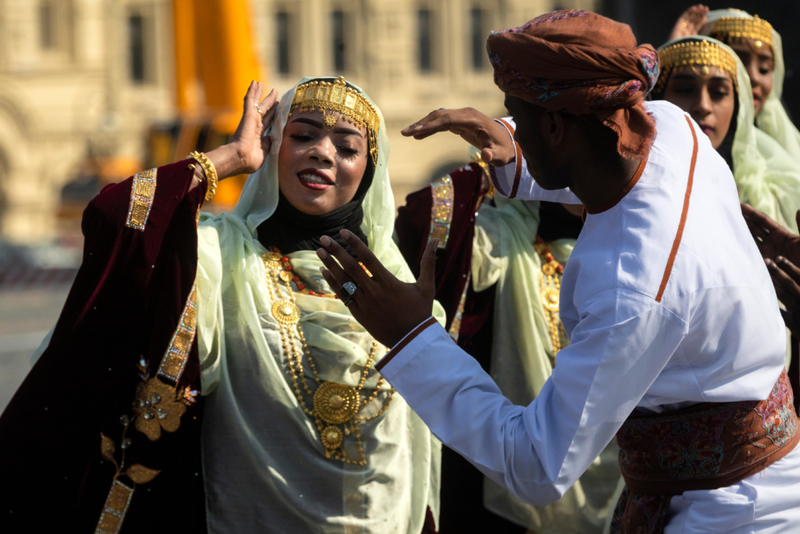
The Bedouin bride also wears a veil that is embellished with heavy jewelry. A henna ceremony is customary, and the henna painting symbolizes luck, beauty, and health.
Sardinia
Located in the middle of the Mediterranean Sea, Italy’s island of Sardinia is steeped in old-world traditions, many of which are borrowed from ancient Greece, Rome, Spain, and parts of Africa. Sardinian brides wear beautifully ornate dresses stitched with jewels.
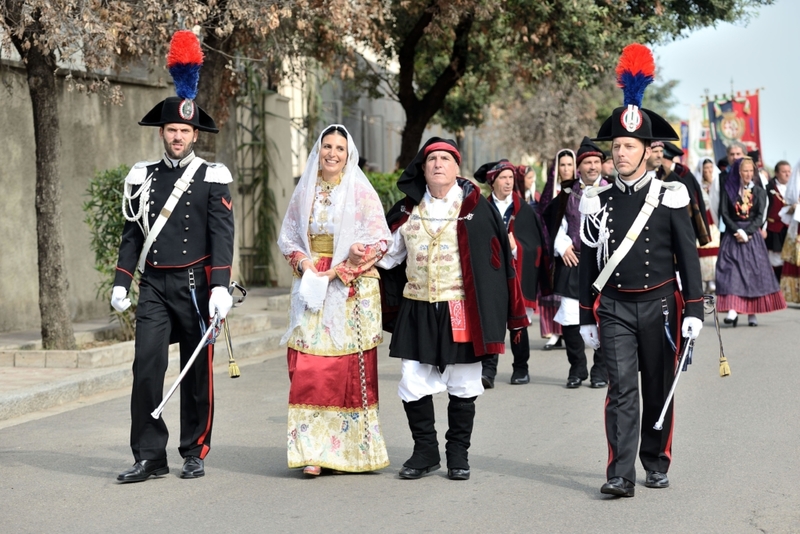
The colors and embroidery designs of her ensemble are unique to each village of Sardinia. She is draped in a distinctively Sardinian long veil and a velvet overcoat.
Japan
The most popular Japanese wedding dresses are Shinto style. The bride wears a shiromuku — a white kimono with a trailing kakeshita hem. A silk robe is worn over the kimono. It’s often red, though sometimes it can be orange or gold.
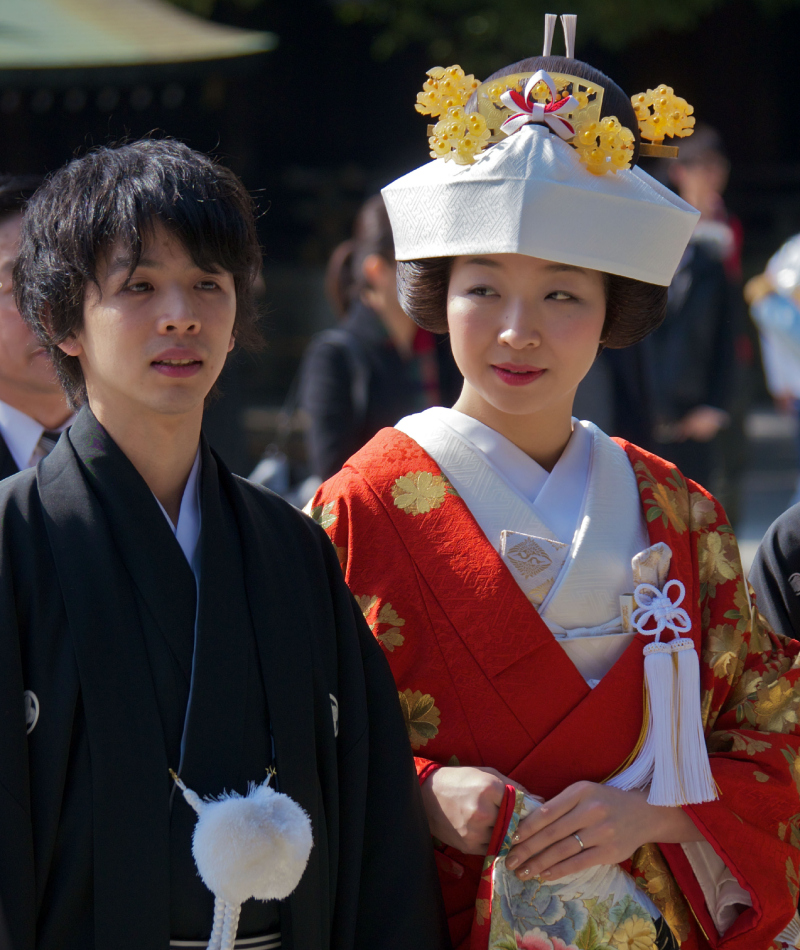
The bride chooses the accent color. She also wears a traditional headpiece. The style has fallen out of favor since the 20th century, replaced with western styles.
Tonga
The Polynesian island Tonga, located deep within the South Pacific sea, is a place with very old customs. The bride and groom wear special costumes made of tapa. Called a ta’ovala, the labor-intensive traditional clothing is lovingly prepared by the family months in advance. A wedding in Tonga can last three days.
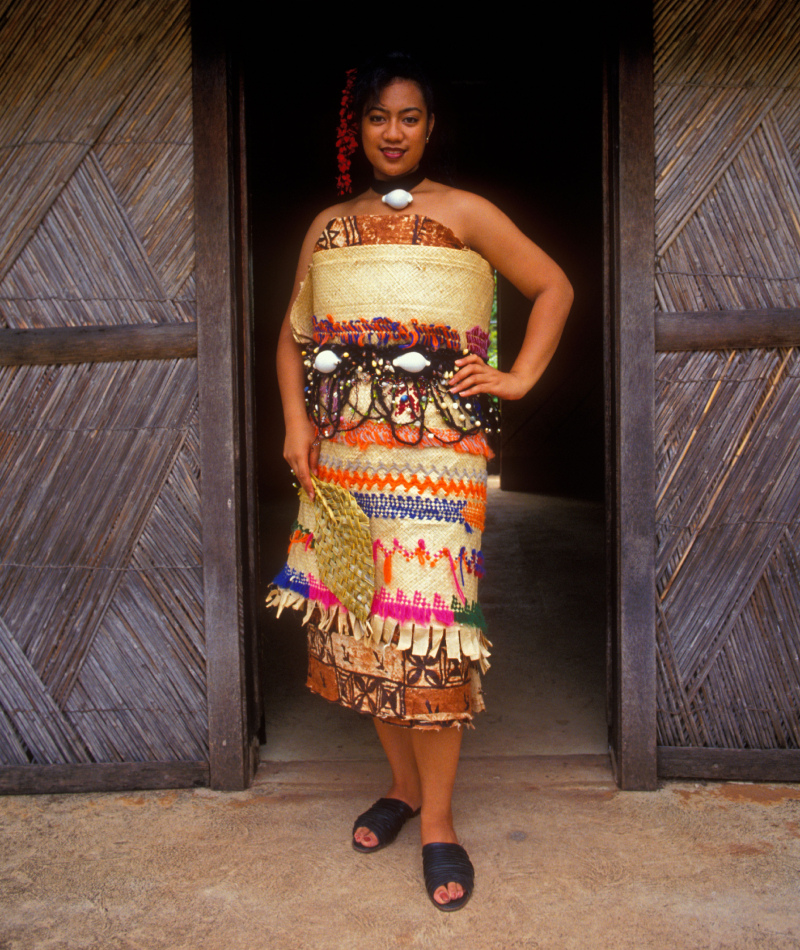
One of the most unique customs in Tonga requires that the groom begins the relationship with his bride-to-be as a friendship.
Russia
Brides in Russia traditionally wear a red sarafan dress, a Russian style of dress that is similar to a pinafore and blouse ensemble. It wasn’t until the 1960s when Russian brides began moving toward the westernized white gown.
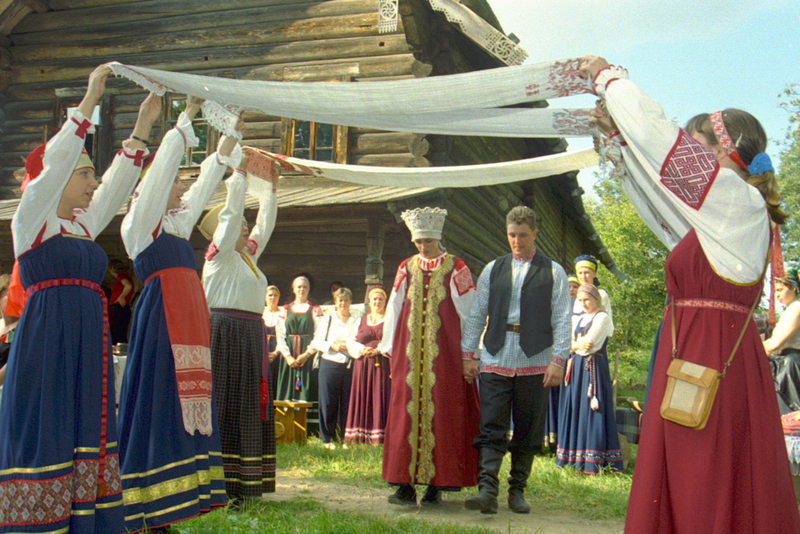
A significant element of Russian bridalwear is the headpiece. The kokoshnik headdress dates back to the 10th century, it is a metal headband beaded with gold thread.
India
India is a vast territory with many styles and traditions, but wedding dresses are often red and marital attire in India is usually made up of three pieces. It is a beautiful ensemble that includes a dupatta, a blouse, and a red and gold lehenga.
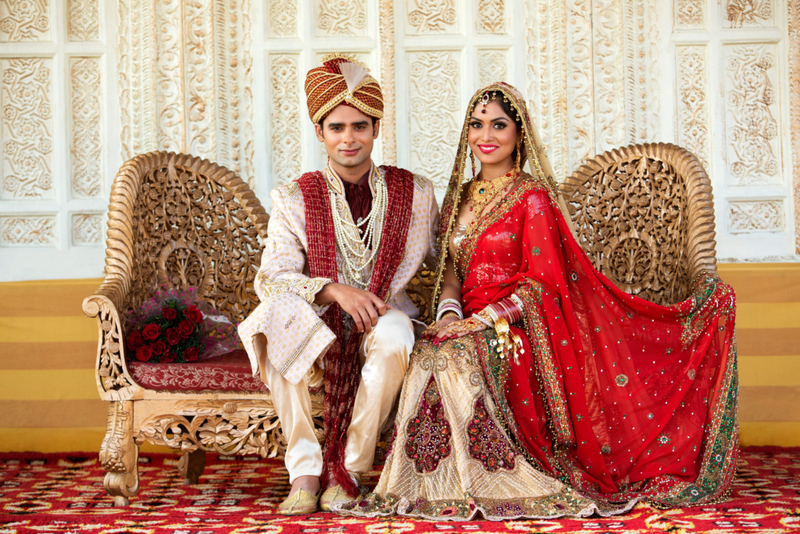
The latter is a long, exquisitely decorated flared skirt, and the dupatta is a traditional shawl-like scarf.
Eritrea
An Eritrean couple in traditional wear looks magnificent. Wrapped in ivory and shimmering gold robes and topped with a majestic crown of velvet, the bride and groom exude royalty. The Eritrean ceremony follows an orthodox Catholic wedding and will go on for days.
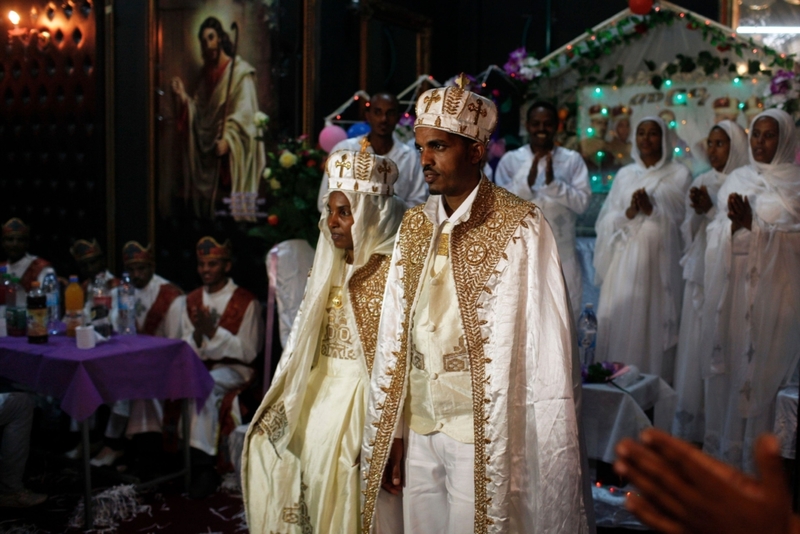
This custom is called a Melsi ceremony. It is full of rituals, traditional foods, and symbolism and is based on ancient Eritrean ways.
Portugal
In Portugal, the culture comes from centuries of influence by Catholicism, European royalty, and ancient Moorish customs. Brides do not wear a white gown from Catholic churches. Instead, pagan styles reign. The bride wears a dark tunic, usually black, with a white blouse and head covering.
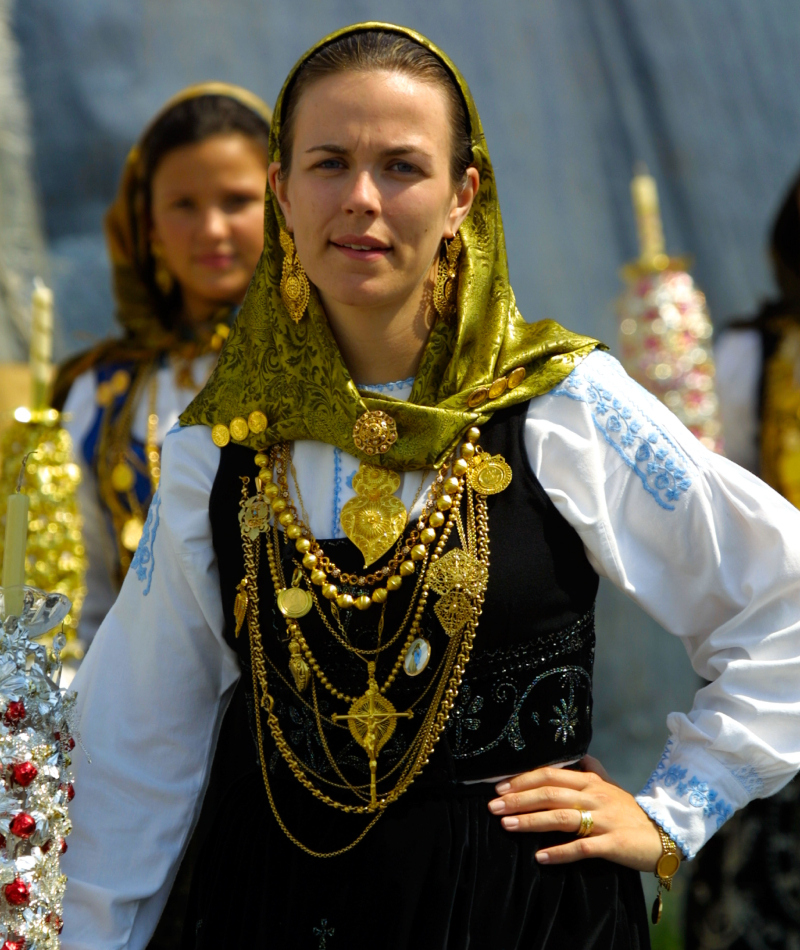
She is heavily ornated in gold filigree wearing. The regalia includes beads from the Moors and crosses of the church. Gold jewelry also pays homage to Portuguese royalty.
Serbia
The most stunning tradition in any Serbian Orthodox wedding is the crowning moment. After the rings are placed on each hand, the bride and the groom are symbolically united with a gilded crown that is placed on the head of each.
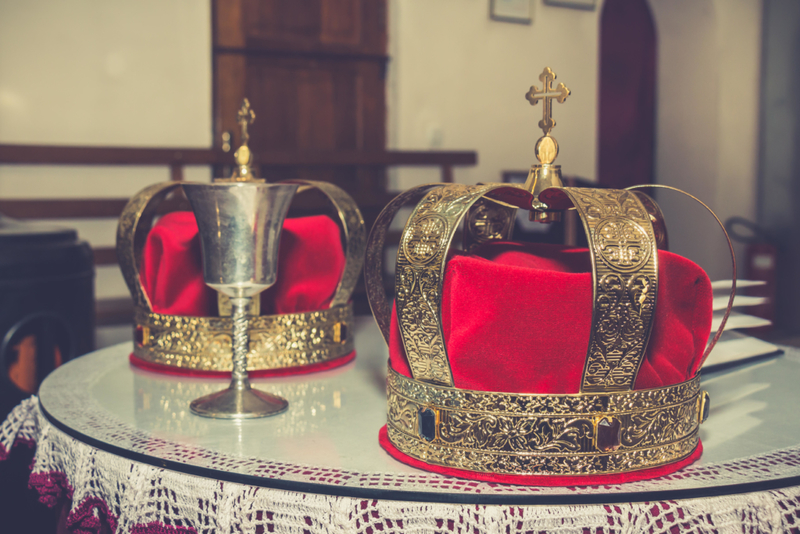
The bride dresses in white. In the past, up until 1846, the groom’s family had to buy the bride with gold or currency.
Afghanistan
Brides in Afghanistan wear a beautiful emerald gown with golden accents. They have the option of wearing a red dress but green is most commonly chosen because it is symbolic of wealth and fortune.
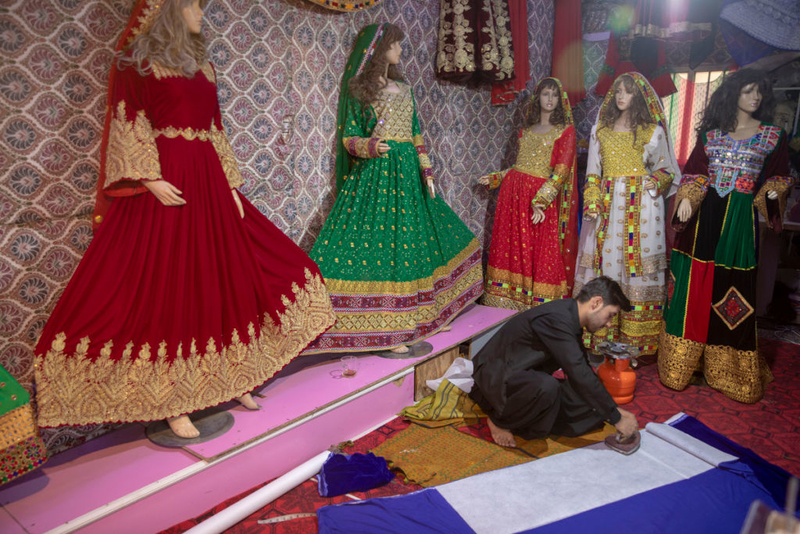
Whichever color, it is elaborately hand embroidered. An Afghan bride participates in the henna ritual the evening before.
Thailand
A bride from Thailand can choose from six styles of traditional dress. Her choice usually depends on the customs in her family. They use simple dress designs and usually wear a draped fabric similar to a saree.
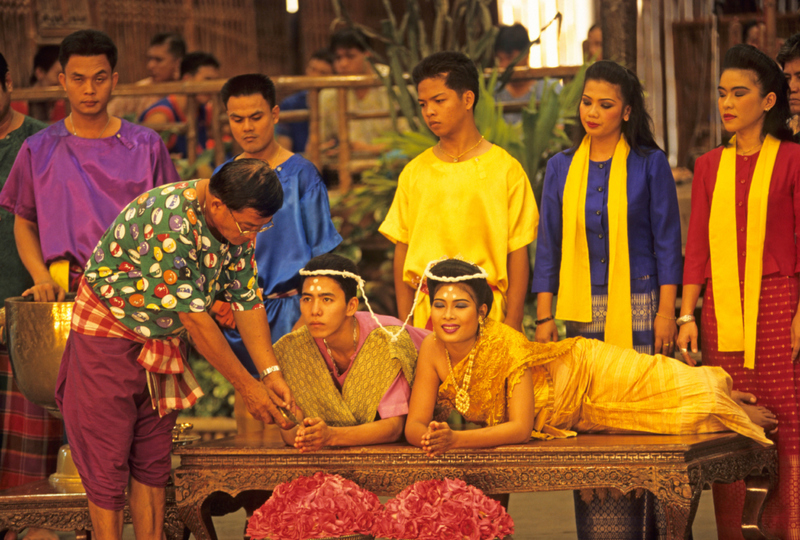
Her wedding gown is made from silk and is usually in a muted color, never black. It is considered bad luck to wear black because it symbolizes mourning. Guests are also expected not to wear black.
Scotland
The tartan sash is the most significant part of a Scottish bride’s ensemble as it is ceremoniously pinned onto her by the groom at the ceremony’s conclusion. Of course, what we visualize first when we think of Scotland is the groom wearing a kilt. So it is not surprising that it is often the pattern of his kilt that drapes the bride. She wears a white gown.
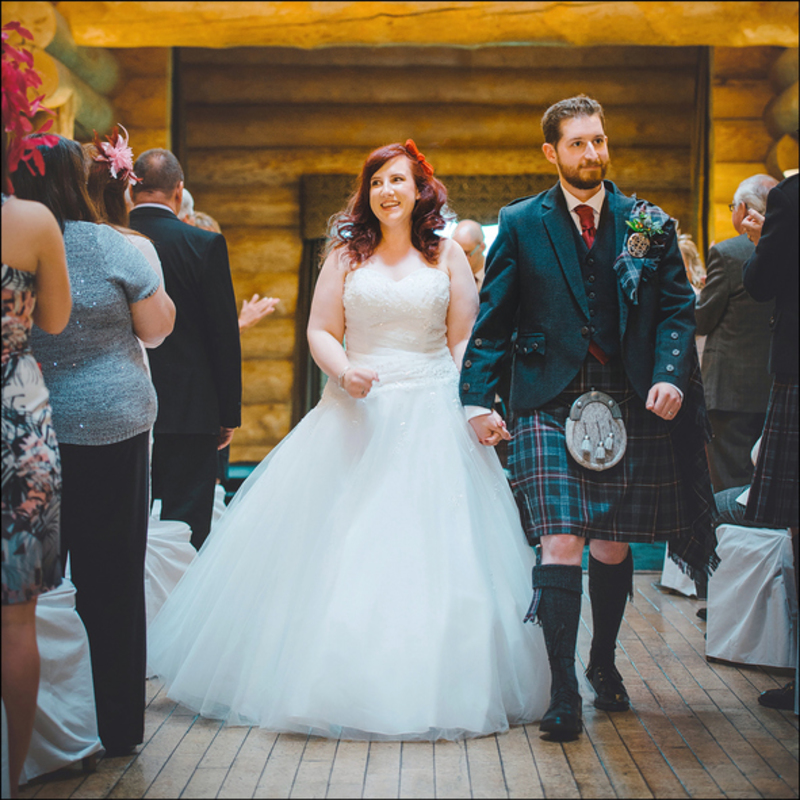
This custom is fairly modern. Older traditions in Scotland, pre-1740, dressed the bride in an arisaid, which is a hooded tartan cape cinched at the waist.
Romania
In the Romanian countryside, weddings are full of folk charm and tradition. A bride is colorfully attired in customary clothing like the Fota, which is a beautifully decorated full skirt. She also wears culturally significant headwear called a Marama.
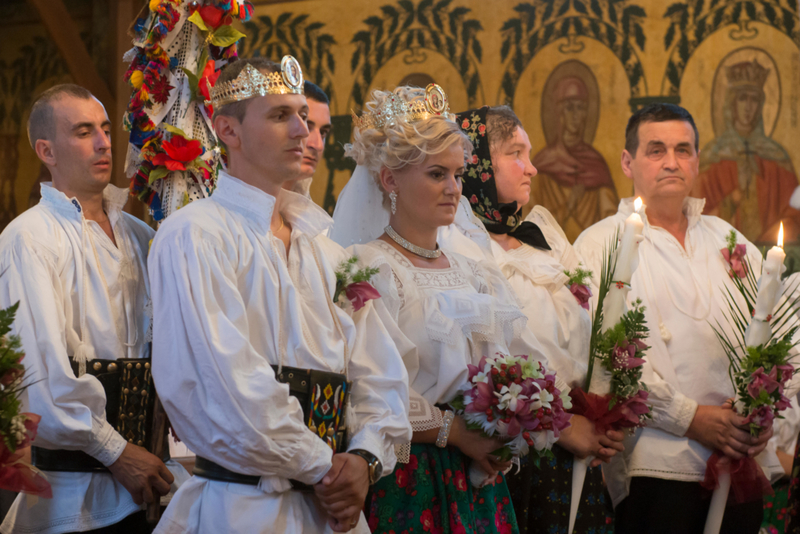
In the upper region of Romania in a town called Oas, elaborate folk weddings are legendary. Up to 1,000 people attend and guests are splurged with every luxury, as is ceremoniously observed, amongst a multitude of other folksy traditions.
Ukraine
Ukrainian brides who opt for a wedding steeped in tradition wear special dresses that are ornately embroidered. Traditional scarves also adorn the bride. The scarves are a unique part of the wedding clothes, gifted to the bride as part of a Ukrainian custom.
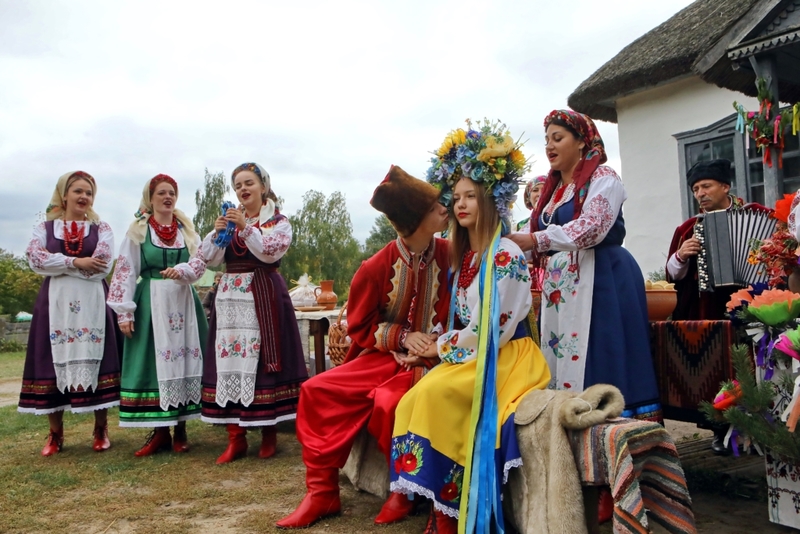
The handwork on the wedding dresses comes from an ancient tradition and the embroidery is as exquisite as it is complex.
China
In China, red is the traditional color for brides. It is considered to be a strong color that can ward of evil spirits and deliver luck and happiness. Her dress is decorated with sequins, pearls, and colored embroidery.
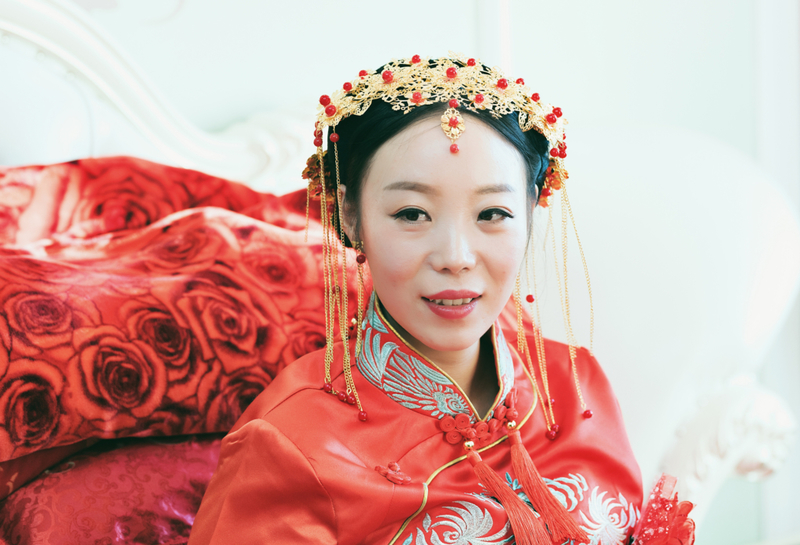
Chinese brides wear a "qun kwa", which is a two-piece outfit. It makes sense that white is not a wedding color in China as it is the traditional color for funerals.
Yemen
A Yemenite wedding is flush with ancient traditions and ceremonial splendor. The bride is crowned in grandeur wearing an intricately beaded conical headdress. Known as a gargush, it is primarily red and patterned symbolically. It’s large and resplendent. The jewelry of the bride is another marvel. Her chest is covered in all sorts of silver, beads, coral, amulets and weighs several pounds.
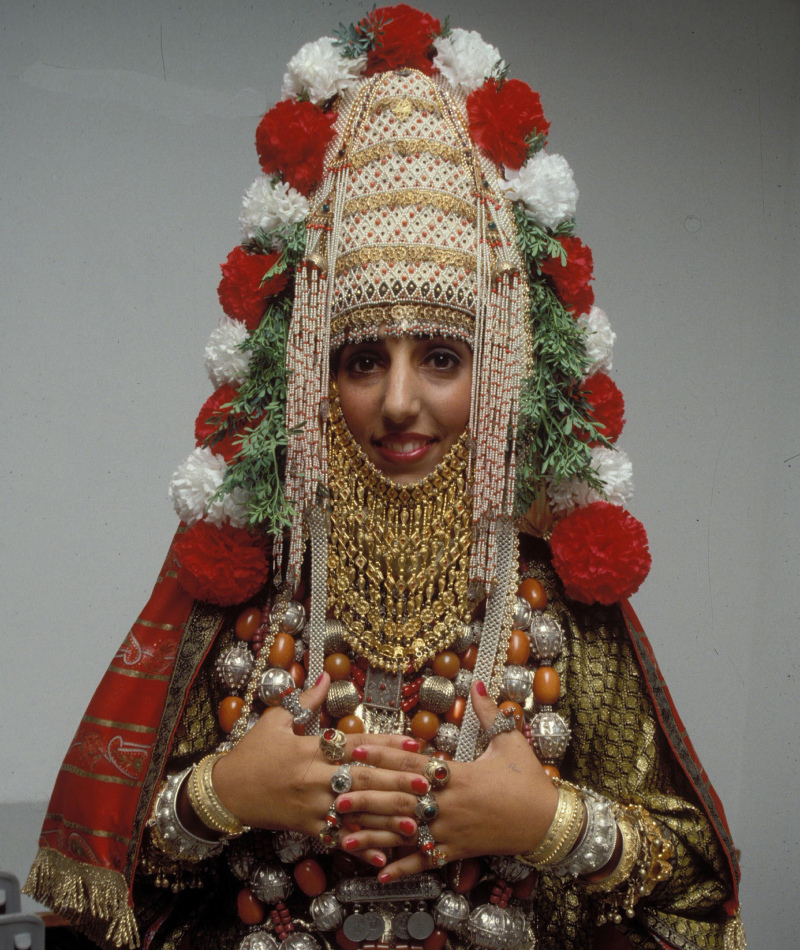
The Yemeni bride also takes part in a henna tradition the night before the wedding which includes drums playing while the henna is applied.
Tibet
The groom’s family is responsible for providing the bride’s dress. They wrap the gown, headdress, and jewelry in silk, along with a small Buddha statue, and the groom delivers it to her home on the day of the wedding. The wedding dress is typically a white woolen gown that is layered with colorful robes.
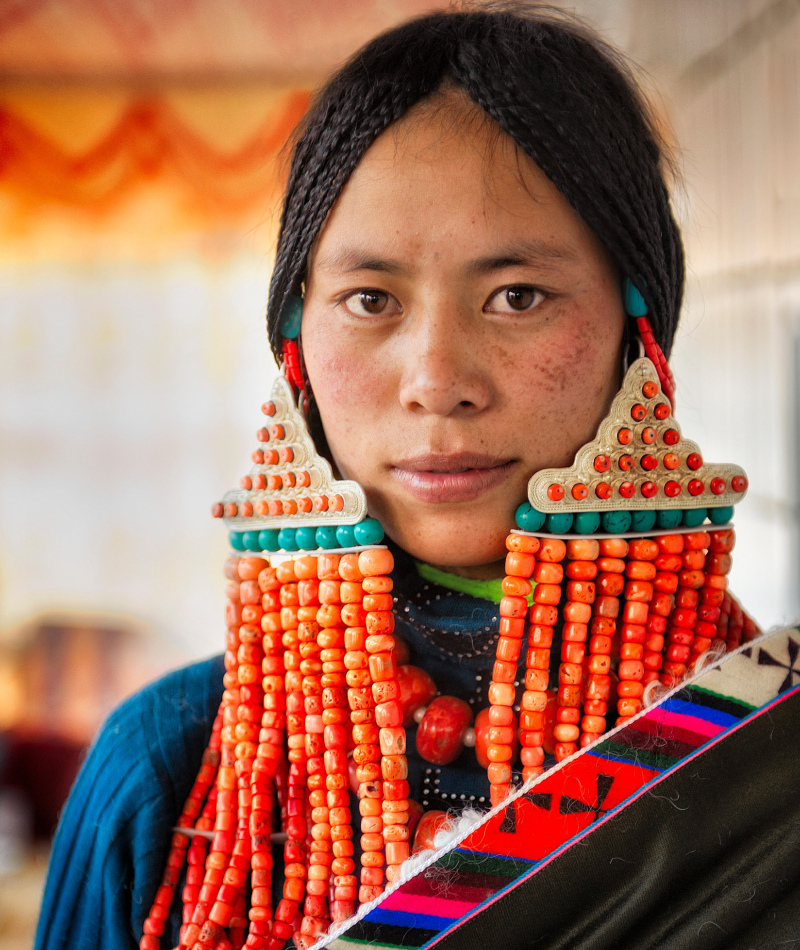
The headdress is ornamented with silver coins and huge earpieces are worn. The many layers of robes oftentimes bury the bride from view!
Korea
Ceremonial traditions of Korea date back many centuries to the Koryo period in 918 AD! Traditional Korean wedding dresses are made of blue and red silk. The colors represent male and female, respectively. Blue is symbolic for males, and red, females, and together they represent the cosmic principle of yin and yang.
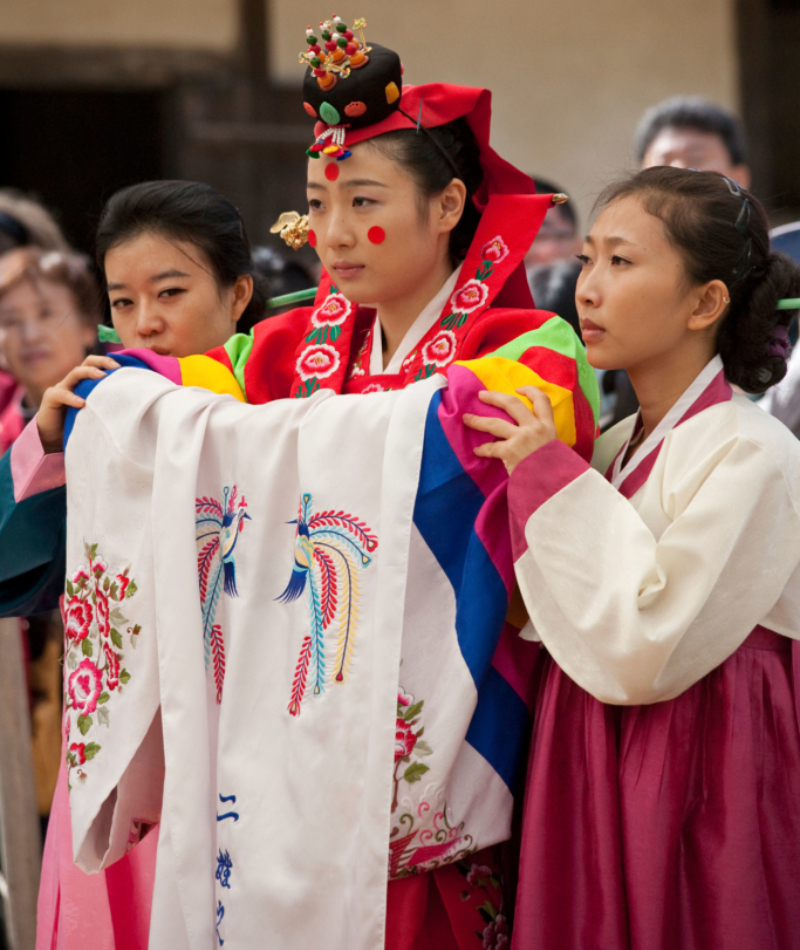
Women wear a bridal headpiece and ceremonial dress called a hanbok. Grooms wear a hanbok as well. Other than the clothes, Korean brides also wear a red dot on each cheek in a custom meant to ward off evil spirits.
Basilan
The Yakan people come from the Sulu Archipelago and inhabit the island of Basilan, which is at the most southern tip of the Philippines. They are an indigenous Muslim tribe. Brides wear customary face painting and their dresses are made of satin or cotton.
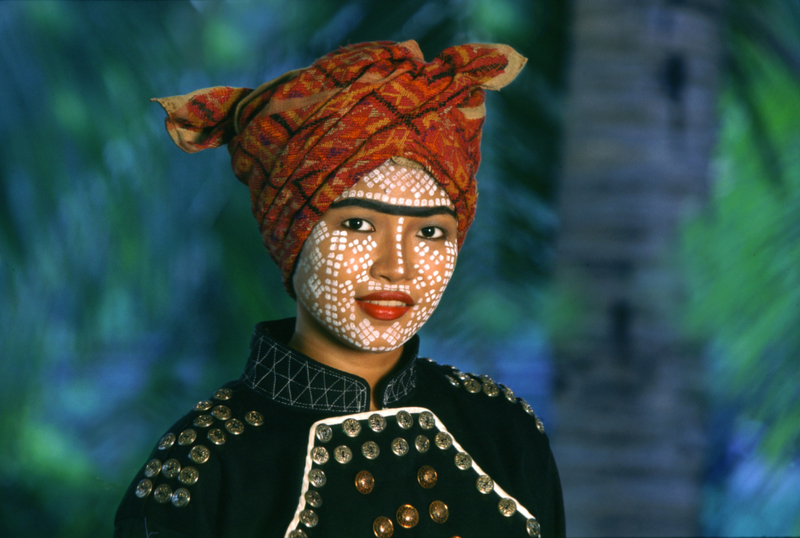
The wedding is conducted by the village Imam who presses his thumb on the bride’s forehead to signal the marriage is complete.
Germany
The traditional bridal crown of Germany is a very old custom. The distinctive headpiece would be worn on special occasions and holidays through a girl’s life, and then for the final time as a crown at her wedding.
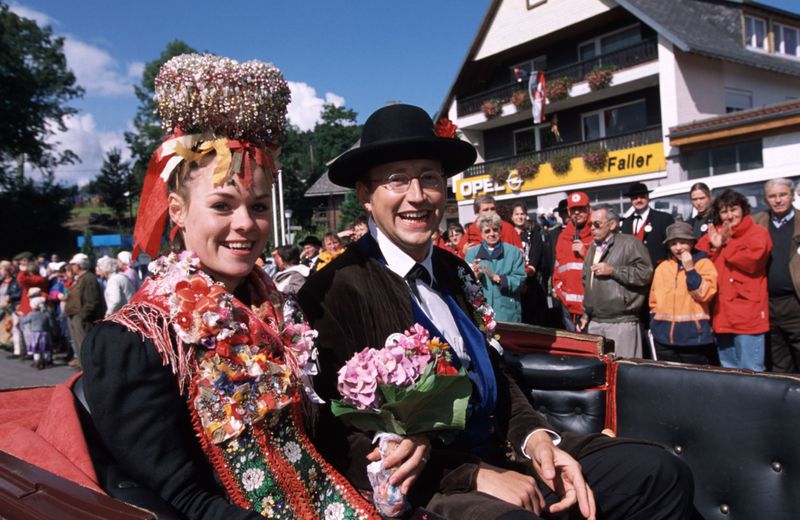
The bridal crown, called a Schäppel, is the most significant element of German wedding attire. It is decorated with a colorful array of silk flowers, pearls, gold, silver, ribbons, mirrors, and more but varies from region to region. Other than the crown, the bride chooses her own dress or wears an heirloom from her mother or sister.
Vietnam
These days, reds and pinks are the colors of choice for Vietnamese brides. However, traditional wedding gowns that hark back to the styles royalty donned during the Nguyen Dynasty are still worn.
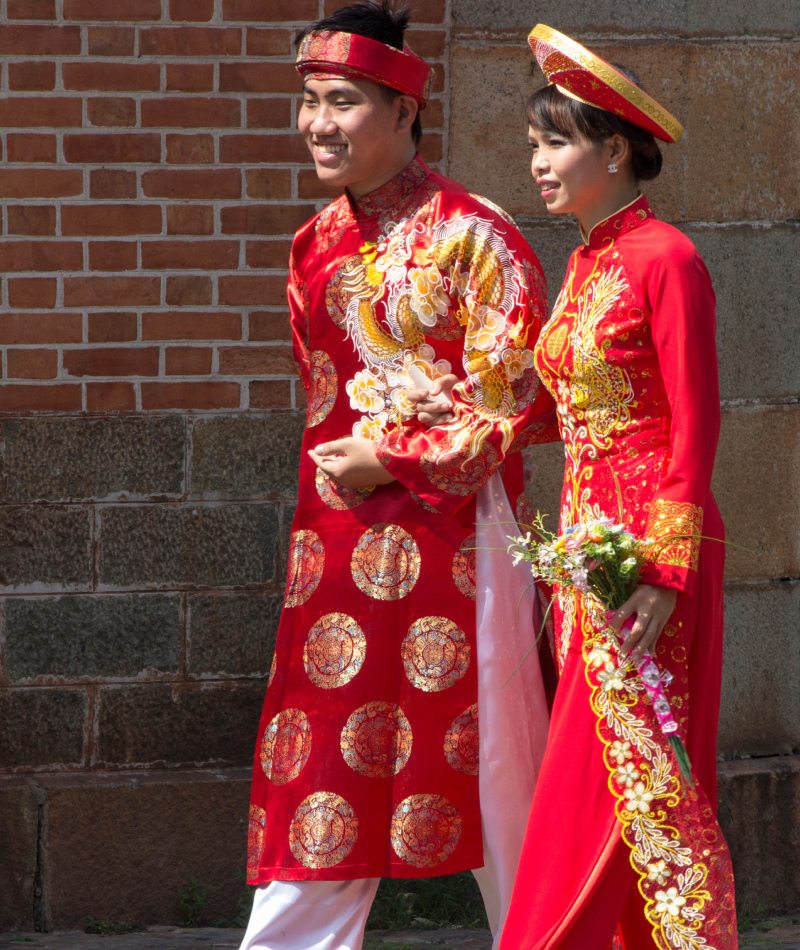
A bride in traditional dress wears a red long-sleeved, floor-length gown, known as an Ao Dai. It is a simple but elegant ensemble topped off with a traditional headdress.
Ghana
Colorful patterns that are unique to each tribal family make up the wedding attire in Ghana. The bride is adorned in an Iro, a wrap-around skirt, and she wears a Buba on top. A special shawl called an Iborum is also wrapped around her.
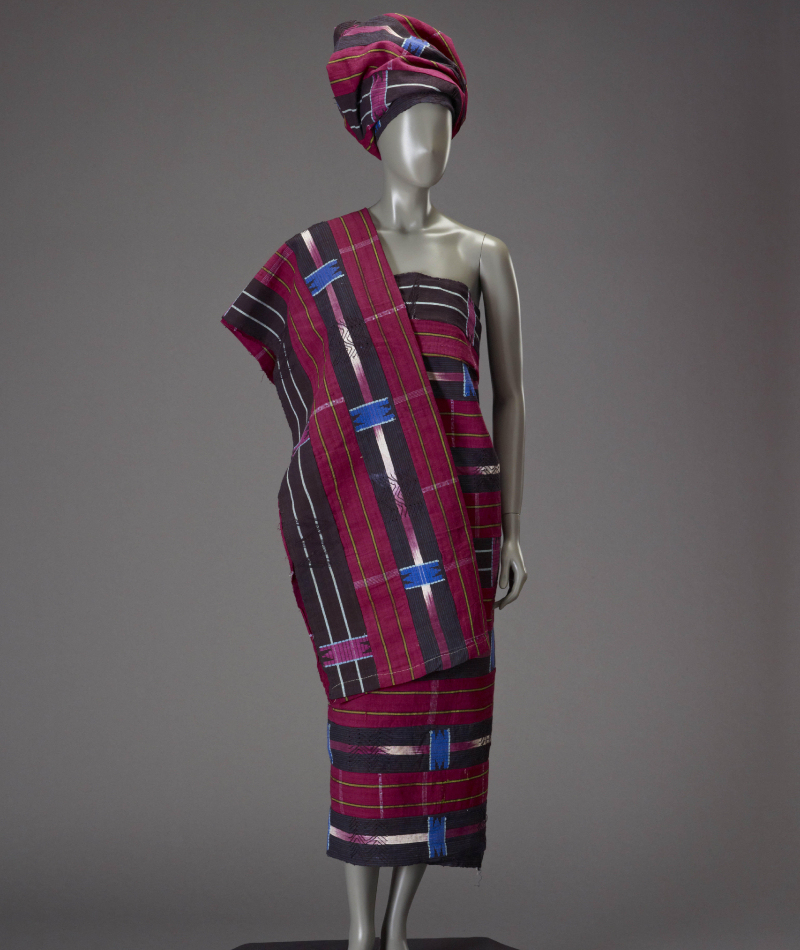
The groom is dressed in the same colors and patterns many times. Those bright colors add to the liveliness of the wedding which is full of music and dancing.
Nepal
Similar to traditions in India, Nepalese brides are married in rich hues of red and gold. She wears a red sari which is threaded in gold and sequined. A traditional Chuuni is worn over her face which is a mesh veil-like covering. A Dori tie cascades from a bun in her hair.
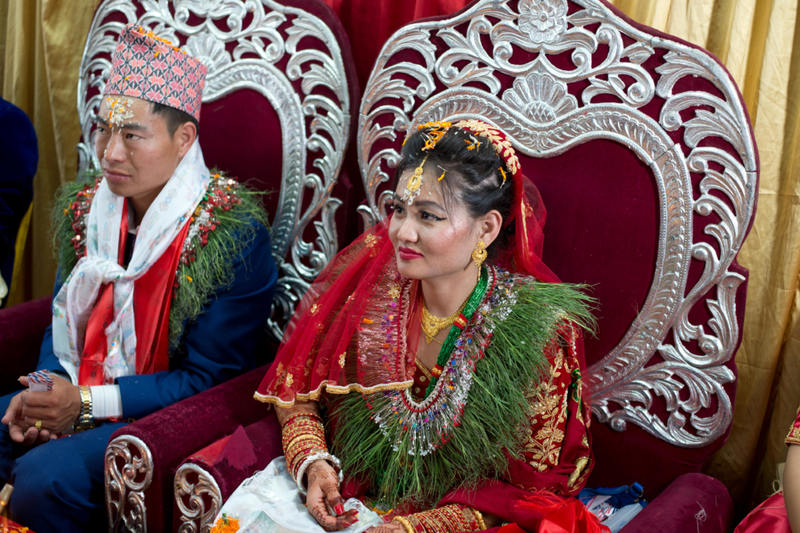
Most Nepalese brides adorn their hands and ankles with henna. The mehndi designs sprawl intricately up her arms from the fingertips.
Samoa
Samoan brides are decorated in flowers, beads, and shells. The material of the dress is culturally unique and important. Tapa cloth, which is one of the fabrics used in creating the garment, is made from mulberry bark. Another cloth made of bark is siapo and it comes from hardwood trees.
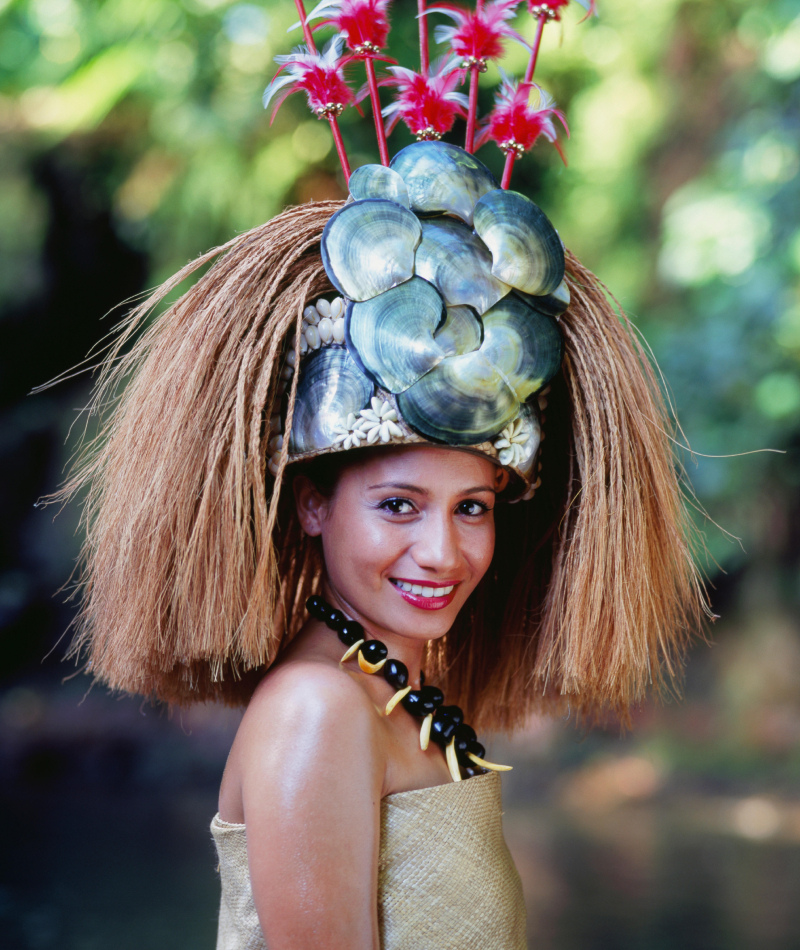
Samoan culture requires the bride to be dressed in these ceremonial fabrics which are colorful and patterned.
Bhutan
Customarily, the Bhutanese bride wears a kira in red, orange, and yellow shades. Her dress is made of silk and paired with a scarf. The groom wears a gho, which is a traditional robe. Both the kira and the gho were introduced by Zhabdrung Ngawang Namgyel as the national dress of Bhutan in the 17th century.
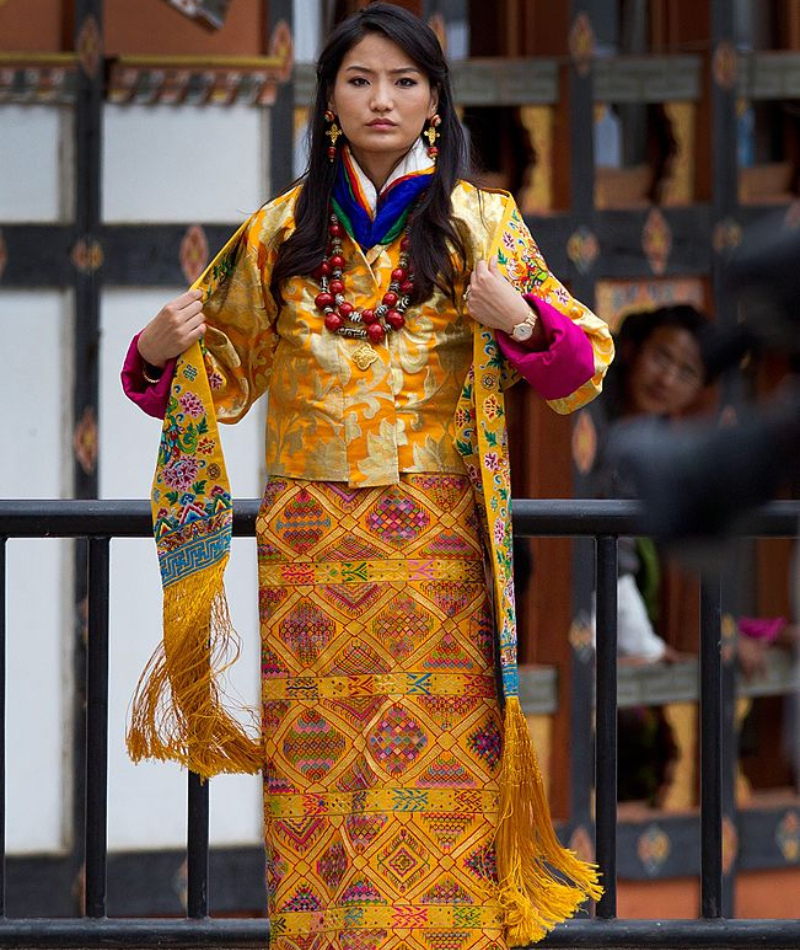
The couple is married by Buddhist monks who ritually chant the mantras and burn incense during the ceremony.
Bali
Balinese brides wear richly decorated clothing that is made of a traditional fabric. The songket fabric, generally red, yellow, blue, or orange, is embellished with layers and layers of gold thread. The golden crown which adorns the bride and groom is stunning and impossible to miss.
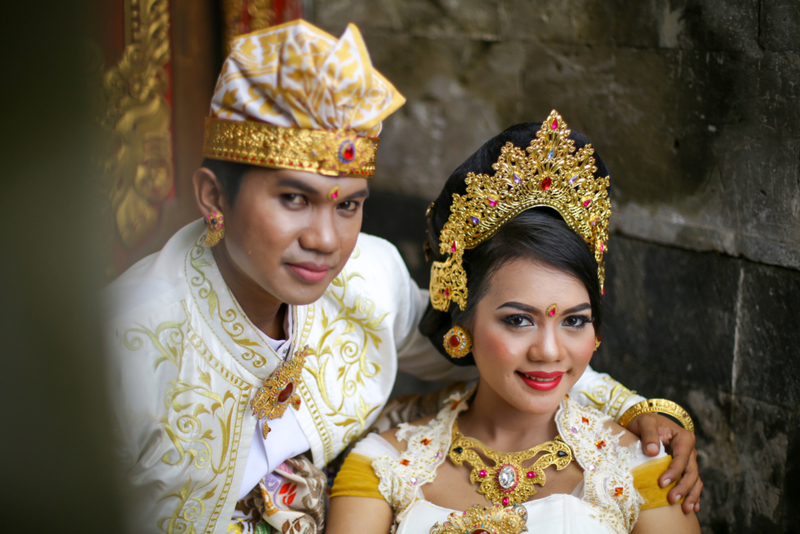
The opulence of the bride’s dress and the height of the crown depend on the family’s caste level — the higher the crown, the higher the caste.
Mongolia
Most Mongol couples are married at the Mongolian Wedding Palace. They wear special clothing called a “deel.” The deel is a festive silk gown elaborately decorated and beaded.
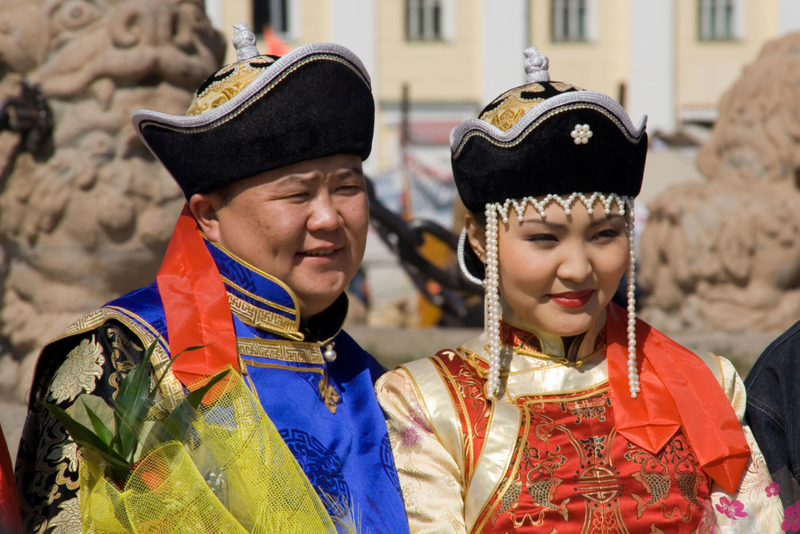
Wedding traditions vary across Mongolia, but, in general, a richly colored deel is worn by both the bride and the groom, though the groom usually wears one in a brighter color. It is customary for the groom’s parents to choose the bride’s clothing and come to her house to adorn her.
Gora Region (Kosovo)
The Gorani people follow the muslin faith, however their ways of life consist of many traditions and elements that are not necessarily related to the Islamic world.
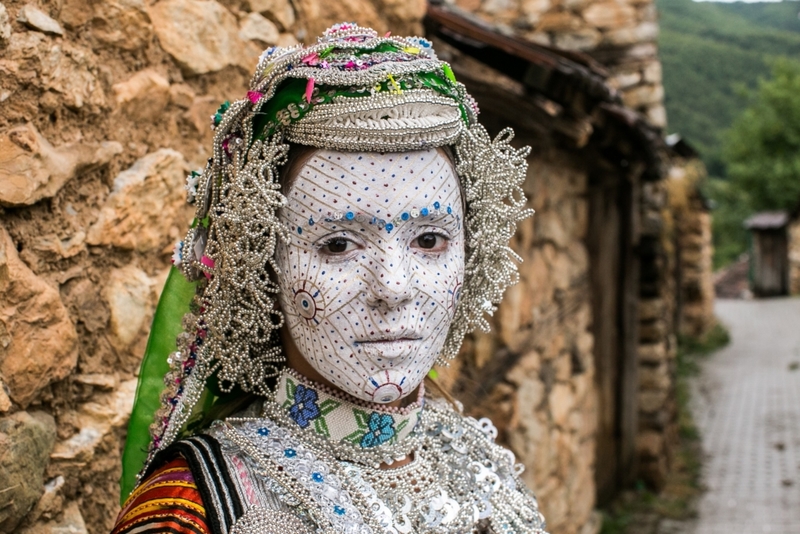
The bride arrives at her wedding on a white horse, carrying an umbrella and decorated in traditional adornments. The bride is then carried to her husband's next-door house until they are united.
Indonesia - Batak Tribes
Indonesia has more than 17,000 islands with more than 300 ethnic groups. Each group has its own traditions, different language, and different wedding dresses. The Batak Toba is set in the highlands of Indonesia. The bride (and groom) are dressed in traditional costumes.
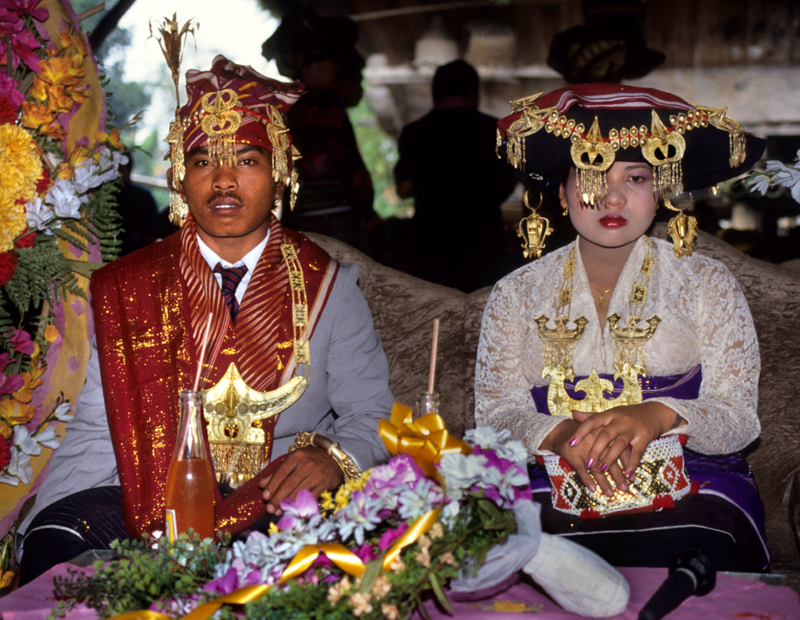
The bride's gown is made of lace and white, and she is decorated with golden ornaments, and small bells attached to the headpiece. When the bride arrives, the bells play their sounds, announcing the bride's arrival.
Norway
The traditional Norwegian bride wears a bunad. It is handmade and made of silk. Even the guests at the Norwegian wedding can be seen in bunads, of one sort or another.
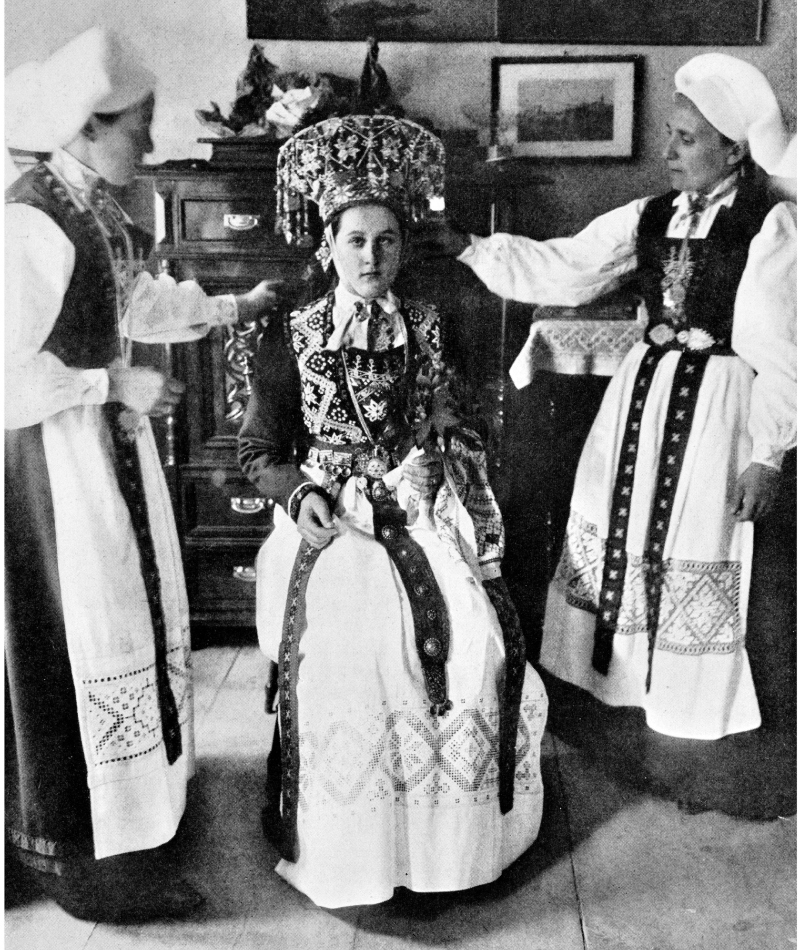
A traditional crown is placed on the bride's head; they are made of pure silver and a vale is attached.
Ethiopia (Hamar)
The Hamar people are from Ethiopia. The collars on a woman represent her statue. Women who have married wear two collars made of metal, while women who are not married, have collars that are made of colorful beads in red, black, and green.
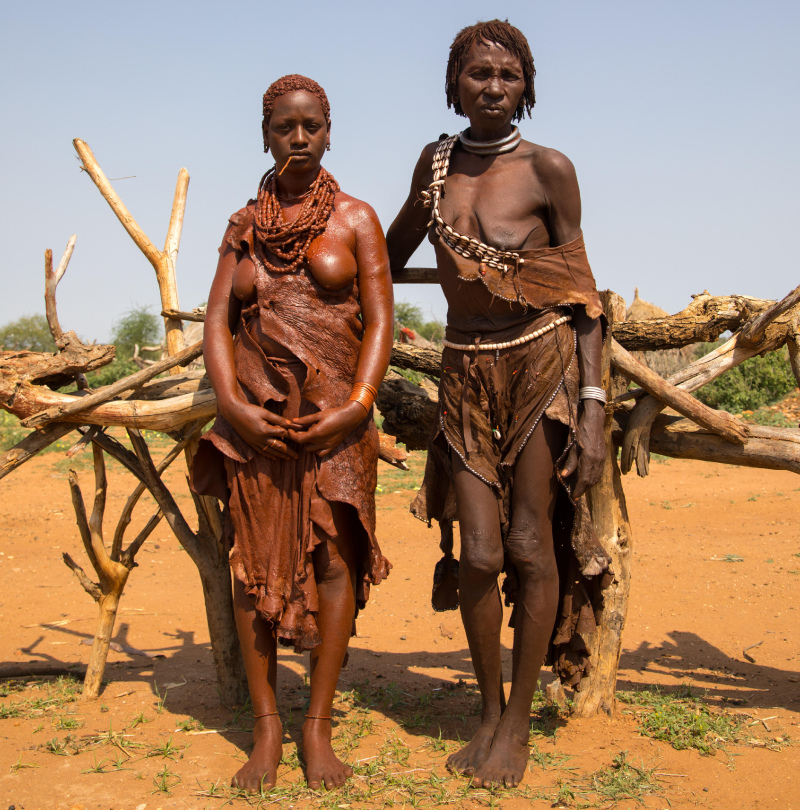
The bride is led by her mother-in-law to the wedding ceremony, where her colored needs, will be replaced by a metal collar.
Malaysia
In Malaysia, most weddings are performed according to Islamic tradition. The bride is covered from head to toe and the detailed fabric of the clothing represents the richness of the culture and its beliefs.
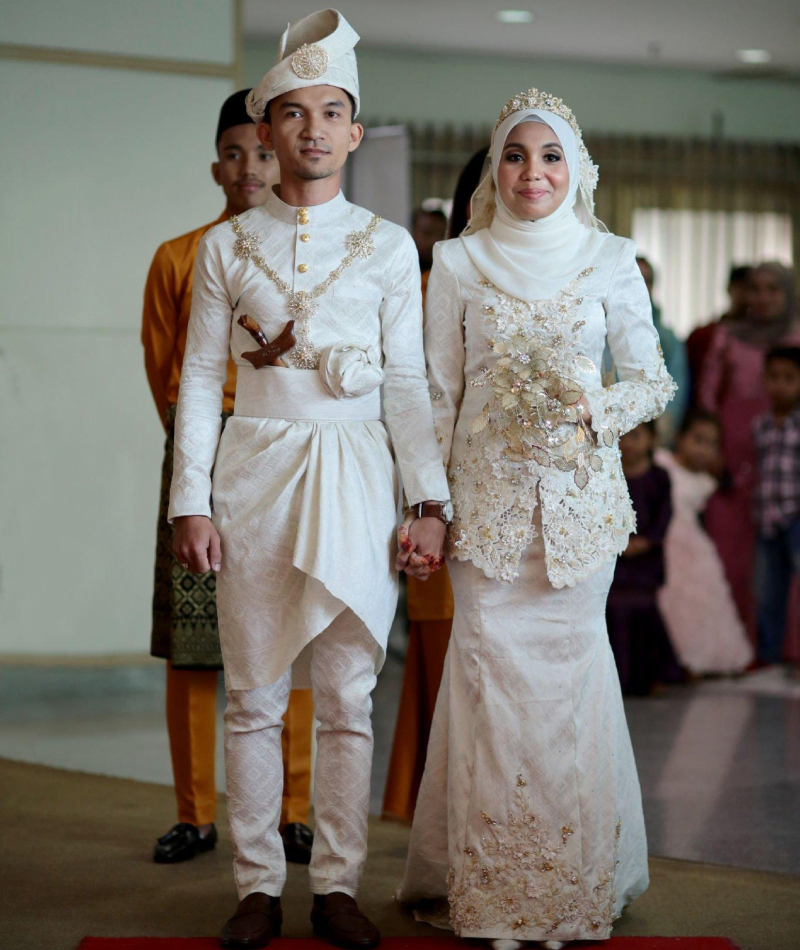
The Bride covers her hair with a hijab, all make from the stunning fabric the dress is made of. The dress is called a baju kurung, and the bride will be wearing it throughout the entire wedding, which can take up to 10 hours.
Jakarta, Indonesia
The Jakarta weddings are different than the Batak weddings for example. The wedding ceremony is different, and of course the wedding dress. The Jakarta wedding dress is easily recognized.

It is covered in golden ornaments embroidered patterns, usually in shades of red and marron.
Uzbek
The Uzbek traditional wedding dress is probably the most colorful dree out of them all. It is handmade and decorated with a sophisticated and complex embodiment.
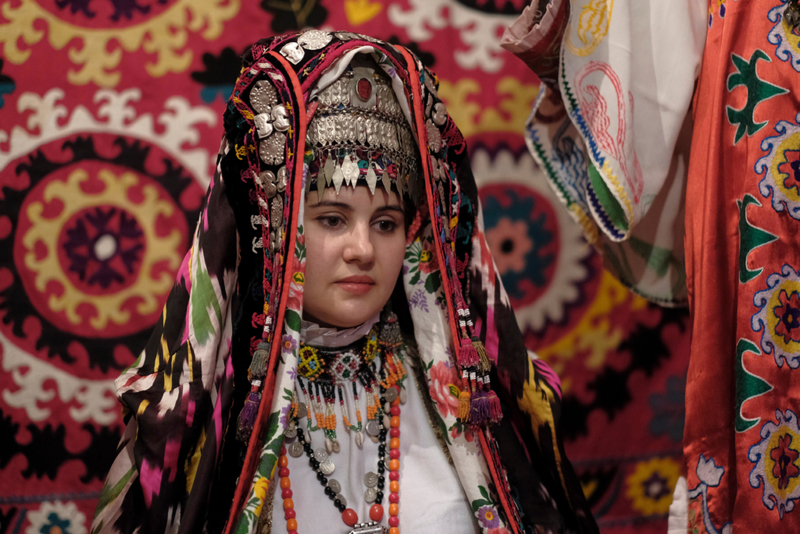
The Uzbeks don't marry only through arranged marriages, however, the same social groups usually mix with their own kind. A huge golden headpiece decorates the bride's head, and as in many traditions, the taller, the better.
Palembang Indonesia
Palembang is the second-largest city in Indonesia. The Palembang too has a different wedding dress than other places on this cluster of islands. Everything about this wedding dress symbolizes the Srivijaya empire.
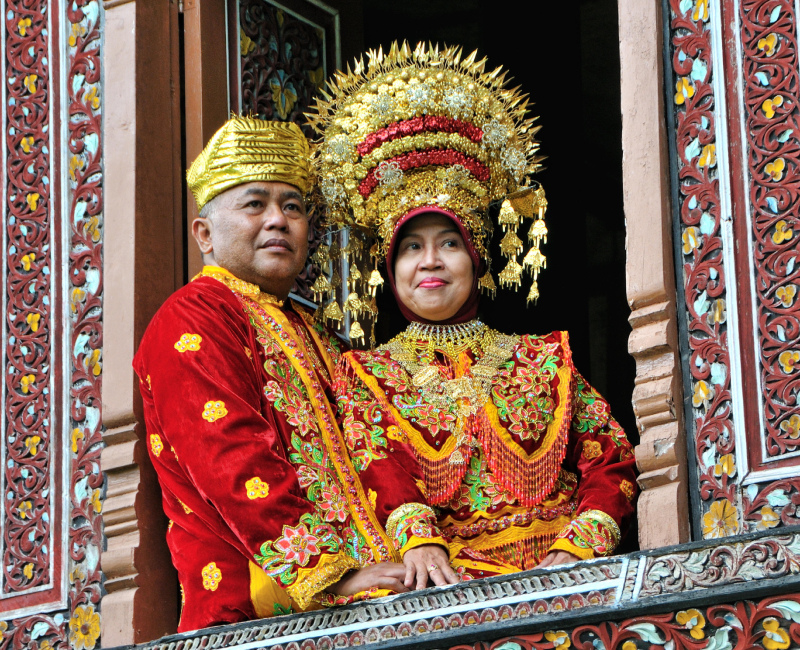
An extra tall headpiece decorated the brides head
Maasai Kenya
The Massai wears a handmade colorful neckless made from shells and beads. Only on the night before the wedding, the bride is allowed to uncover herself and show off her jewelry and garments. Before then, she is covered and hidden away.
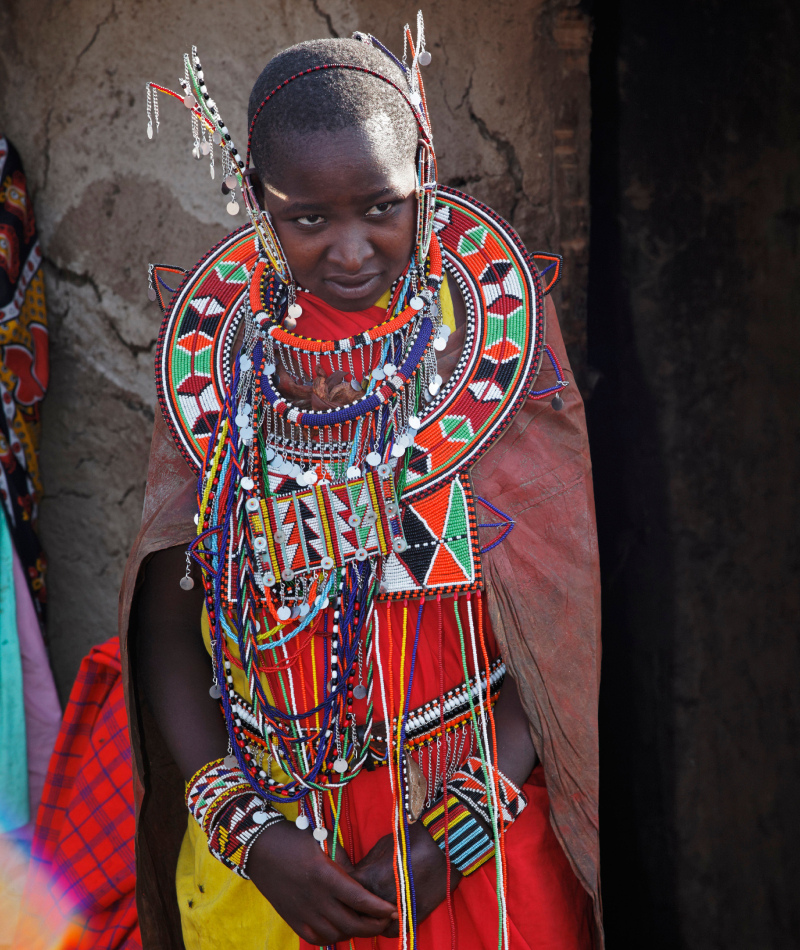
The Massai bride is dressed in a red and yellow dress. her neckless is the main piece the dress is kept simple.
Javanese
Another part of Indonesia is called Java and it has a beautiful tradition and beautiful wedding dresses. These usually include high-necked dresses, a traditional headpiece, and a gown.
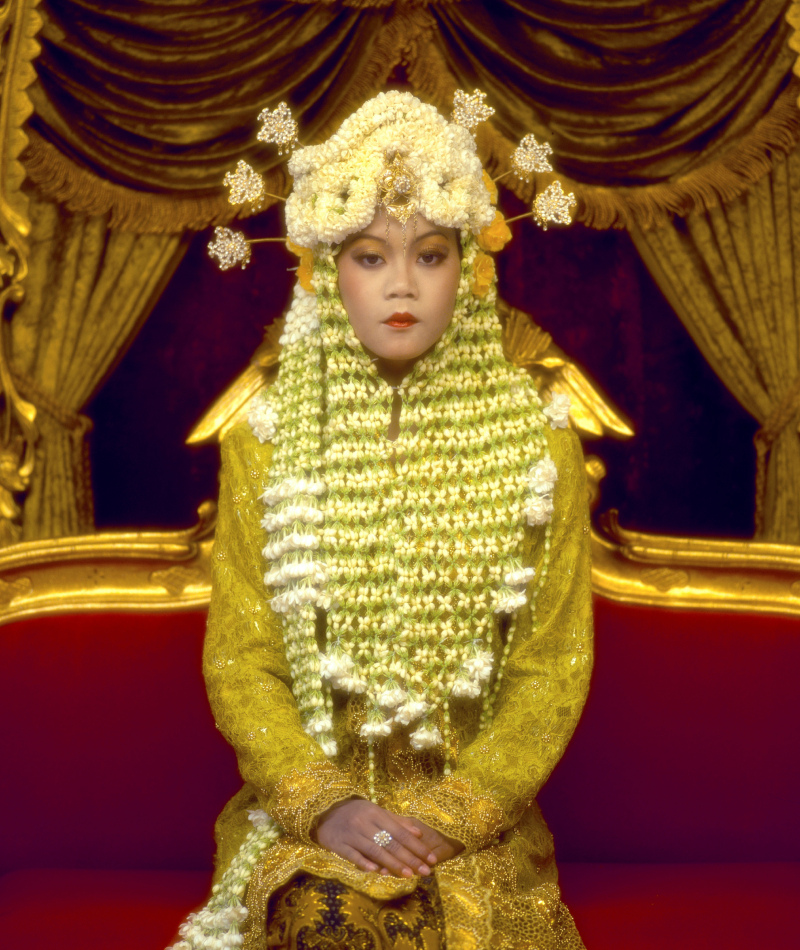
Flowerlike ornaments are colored in gold, creating a decoration for the bride's head. The long gown is golden too, resembling wealth and luxury.
Southwest Bulgaria
In the Ribnovo region in Bulgaria, the people practice traditions that are influenced by Islam. The wedding is celebrated over two days, in which on the second day, the bride's face is painted completely white. She is decorated with flowers and silver ribbons, and sparkling beads are glued to her face.
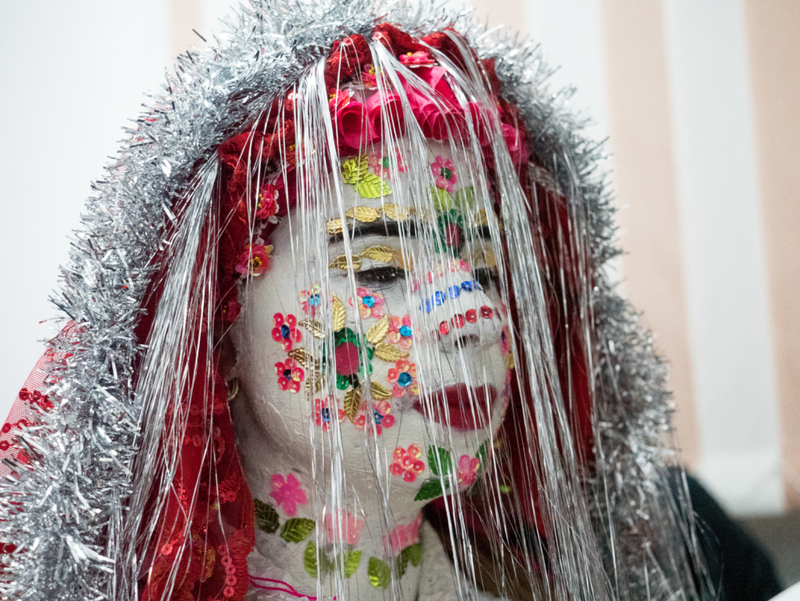
The bride at this moment is at her highest spiritual moment, and the costume resembles purity and youth.
Macedonia
The Macedonian bride wears a typical dress, colored gold, white and red. The Macedonian wedding is known for its unique style and tourists from all over the world travel to take part in the celebration.
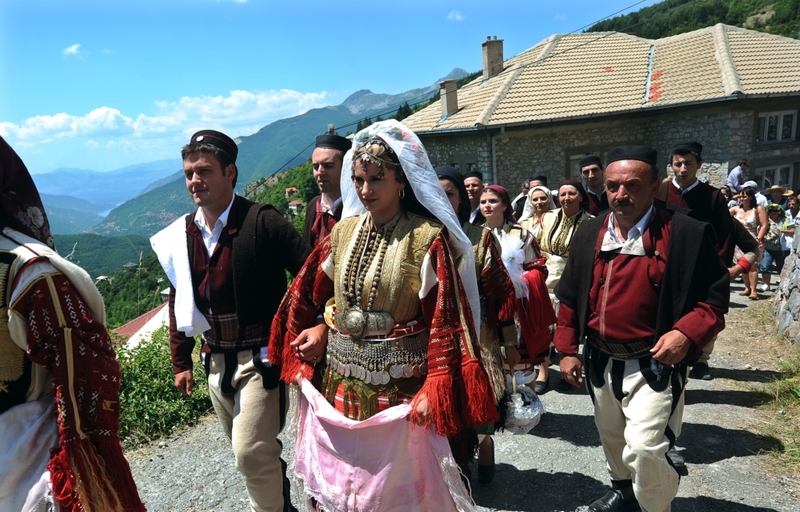
Heavy metal necklaces are worn by the bride, and a white vale too. This traditional wedding style has been kept for years. The wedding dresses design has been preserved for centuries and hasn't changed at all.
Khakas- Russia
The Kahakas people live in one of the coldest places on earth, therefore their wedding dresses had to be designed accordingly. The thick and heavy petticoat is worn underneath the dress which is made of leather, fur, and warm fabrics.
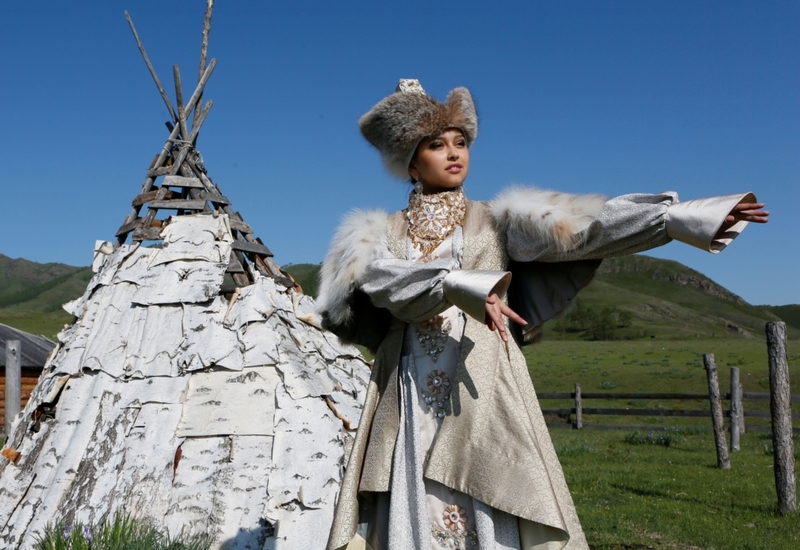
The Yuta tent is s traditional form of habitat for that region, and historically, the natives were former herders, who raised sheep and goats, which the dressed were mad of.
Ultra-Orthodox Jew
Everything in the Jewish ultra-orthodox clothing represents modesty. Only the bride's hands are revealed, while the rest of her body is completely covered. She wears a white traditional dress, kept simple with delicate ornaments.
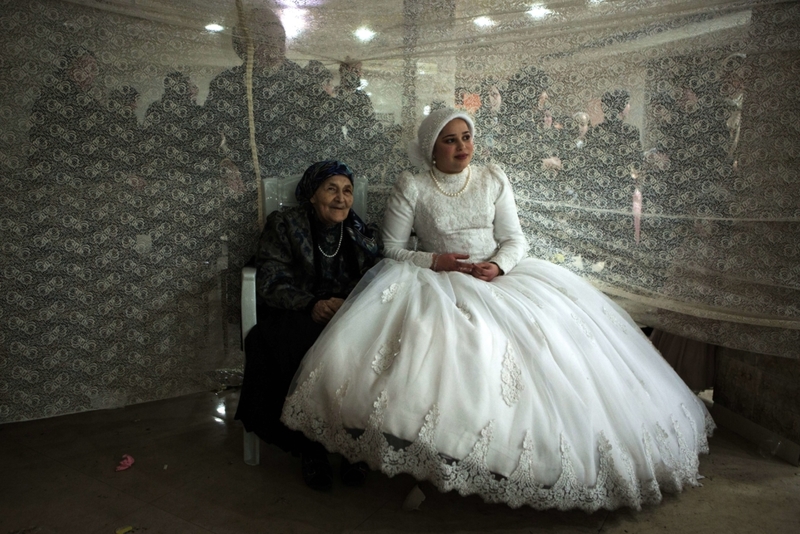
The headpiece is white as well, and she sits behind a curtain that separates the males and females, traditionally in Jewish orthodox weddings.
Xhosa cultural-South Africa
The South African traditions are sourced from many cultures and backgrounds. Cream-colored fabric with black stripes is shared by both the bride and the groom. The bride's face is covered with a short bead veil and the same style neckless is worn.
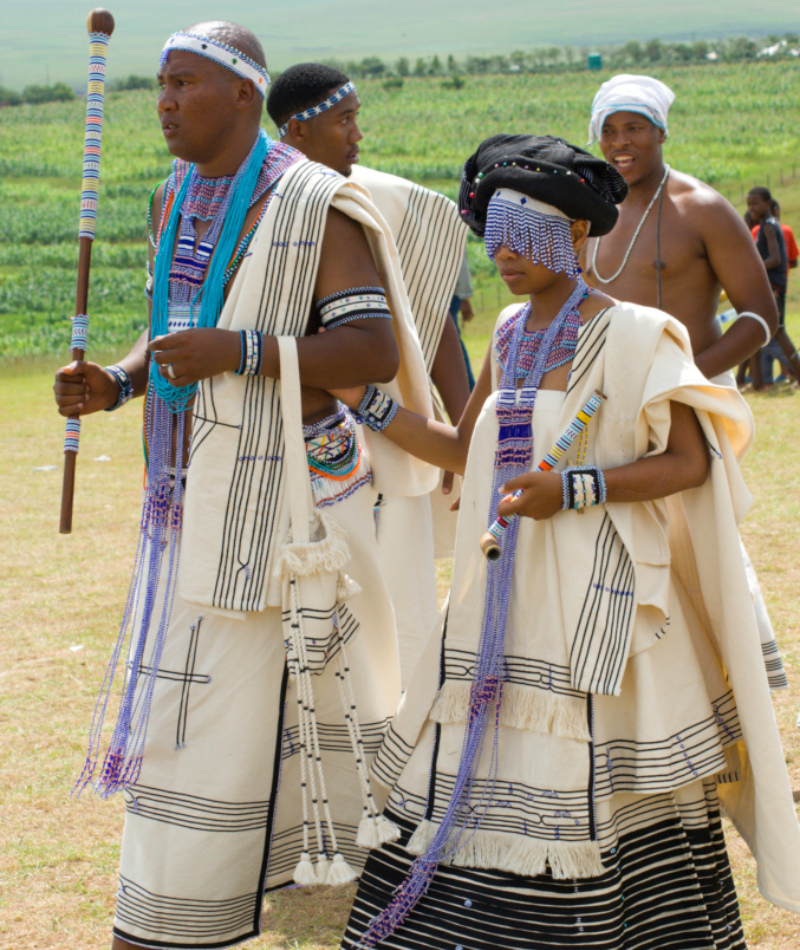
She wears a black hat and a wooden rod is decorated with stripes and colors which represents the couple's tribal heritage.
Tajikistan
In Tajikistan, the wedding dress is white. The wedding ceremony can be celebrated over a few days, and the clothes which are worn underneath the dress may be changed.
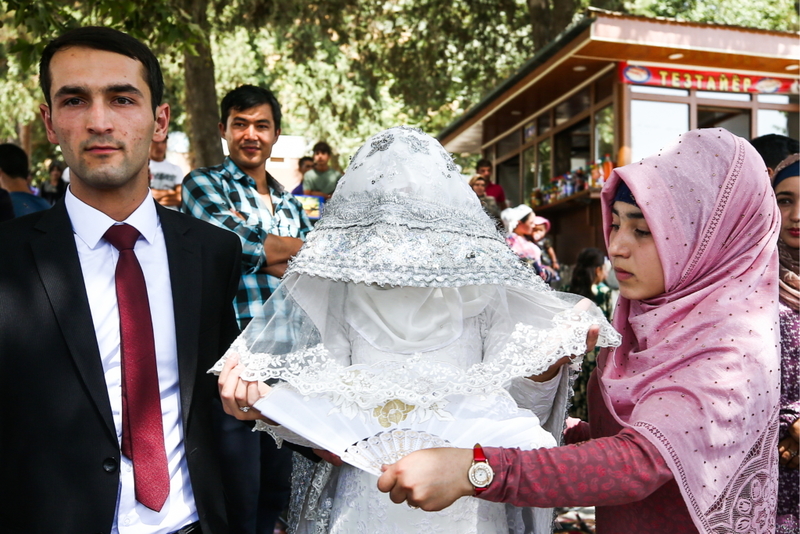
The bride can even wear a pair of trousers underneath the dress that covers them anyway.
Tuvan
The Tuvan region is part of the wild Russin landscape. A thick Sibirian hat decorates the groom's head, while the brides are traditionally covered in a red veil and a white dress.
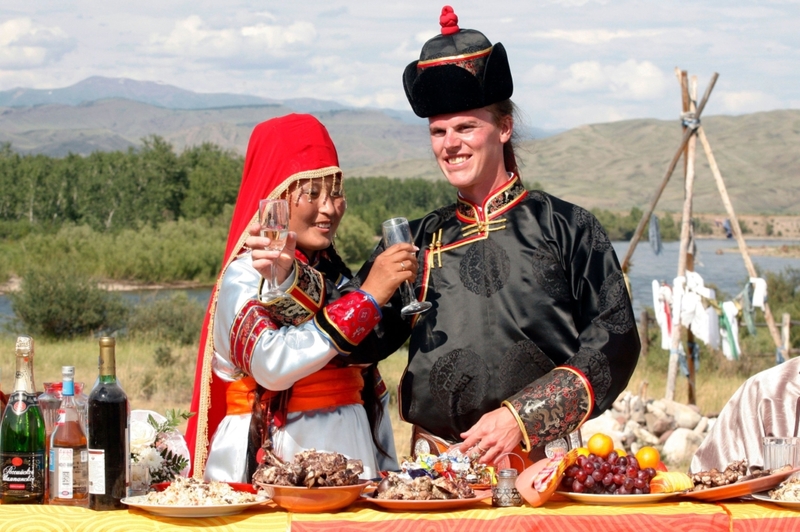
The Tuvan region is located not far from the Tibetan area, and the wedding ceremony is influenced by that tradition.
Jordan
Mass weddings are traditionally conducted in Jordan. The brides wear white dresses and a white veil which covers their face completely.

The Jordanians practice Islam and keep the religion's traditions throughout the ceremony.
Chechnya
The Chechnyan bride is covered head to toe in her traditional white gown. The bride's dress emphasizes modesty and simplicity, and although there are many details on the dress, no bright colors will ever be used.
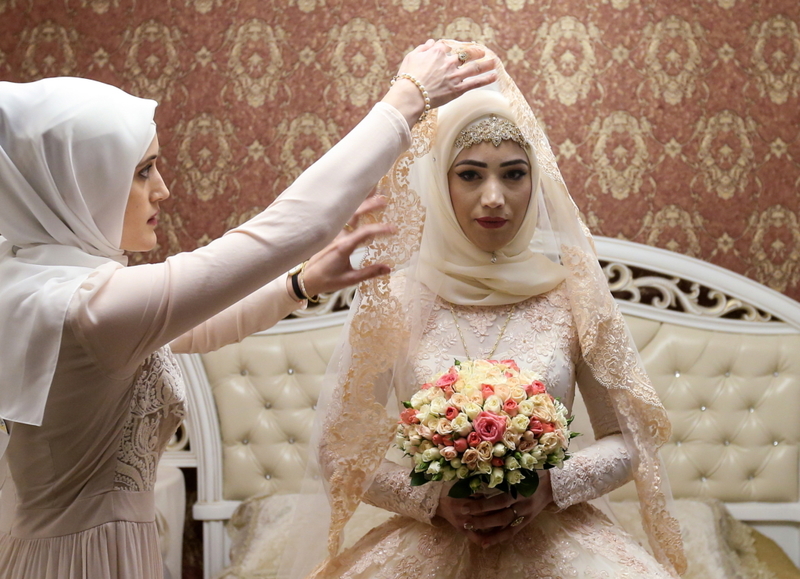
Here as well, Islam is practiced and is shown in the woman hijab.
The Western World
White is the most common color for wedding dresses in the western world, but it wasn't always like this. During the 19th century, women were expected to wear the best dress they has in their closet, and in most cases, it was white.
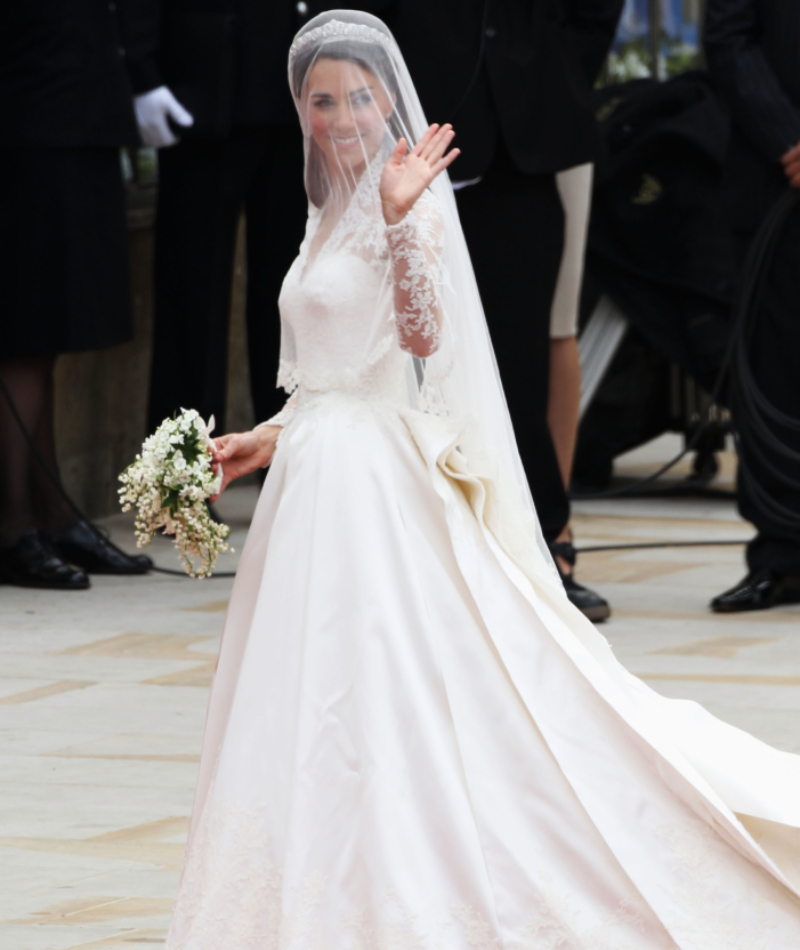
Back in the days, the woman would wear their own wedding dress on several occasions after their wedding, as it became a fancy ball gown.
Algerian
The Algerina bride wears a silk dress with an attached matching headscarf. The Algerian bride might change her outfit during the wedding ceremony.
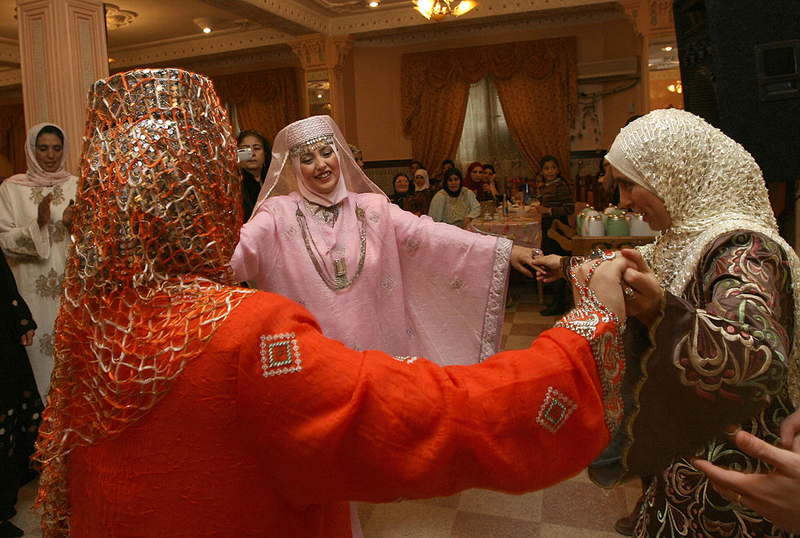
There is even a woman who is hired for the wedding day, and her job is to help the bride change outfits throughout the day.
Caucasus
The Caucasus region consists these days of several countries and republics, however, it used to be one region with no borders between people. Even these days, many couples in that area dress in Caucasus traditional dress.
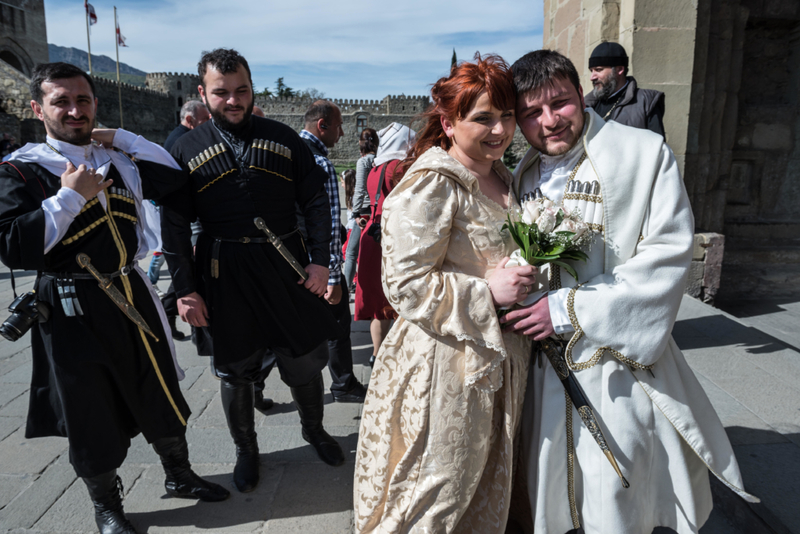
The bride wears a traditional dress made of heavy fabric and adorned with golden ornaments. The dress doesn't seem white in any way and is more of a cream color.
Guatemala
The traditional Guatemala wedding dress is anything but white (except for the veil). Every color of the rainbow is on this dress, emphasizing the happiness and joy of the day.
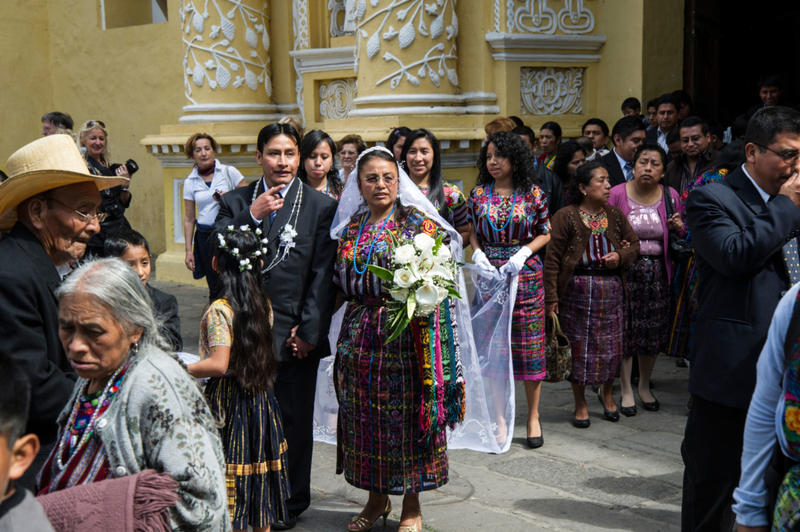
The ceremony is usually held in a church, and all of the bridesmaids are dressed in similar outfits, making it sometimes difficult to tell apart.
Lowicz Area - Poland
Unlike the modernized big cities of Poland, the small villages, such as the Lowicz, still wear traditional costumes at their weddings. A white blouse is traditionally worn, decorated with flowers and colorful stripes.

A skirt and top part, which covers the blouse, are worn on top, all decorated with flowers and lace. The headpiece, that can't be missed.
Berber- (Amazighs)
The Berber people (also known as Amazighs) live in the north heights of Africa, especially Marrocco and Algeria. The Berber bride is covered in gold jewelry and a gold tunic, which symbolizes wealth and richness.
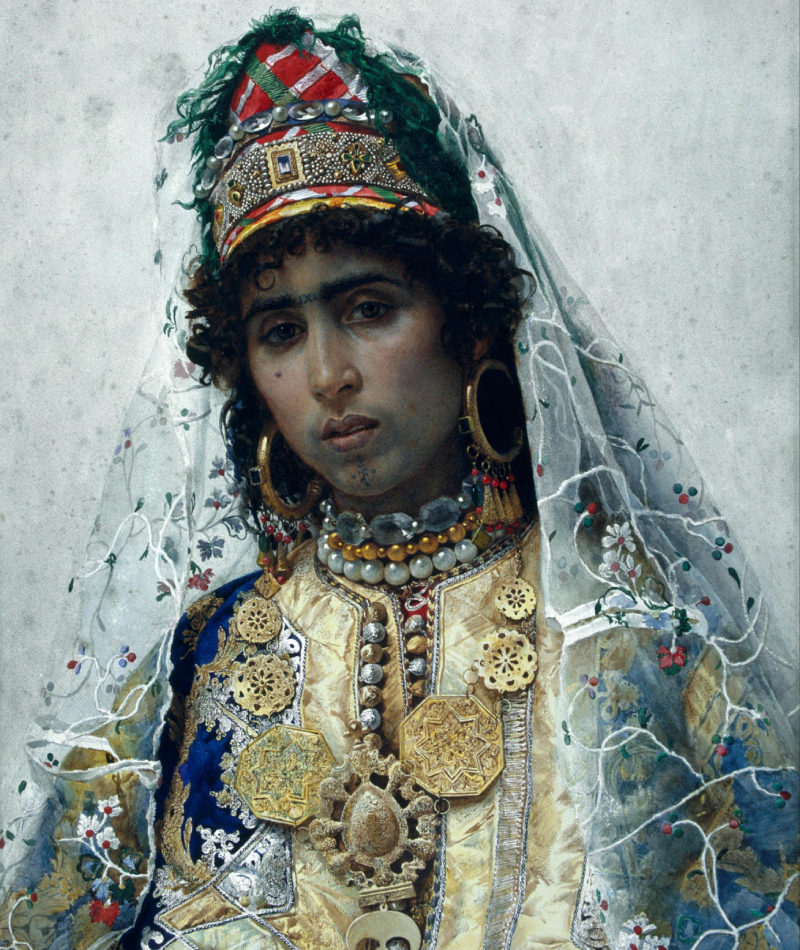
Traditionally big golden hoops are worn on her ears and a headpiece which is adorned with a crown. A white veil decored with flowers is also traditionally worn.
Czechoslovakia
Before the Czech Republic became the Czech Republic and before Slovakia became Slovakia, there was Czechoslovakia. And they had beautiful wedding clothing. Red and bright flowers decorate the dress from top to bottom, and a matching headpiece adorns the bride's head.
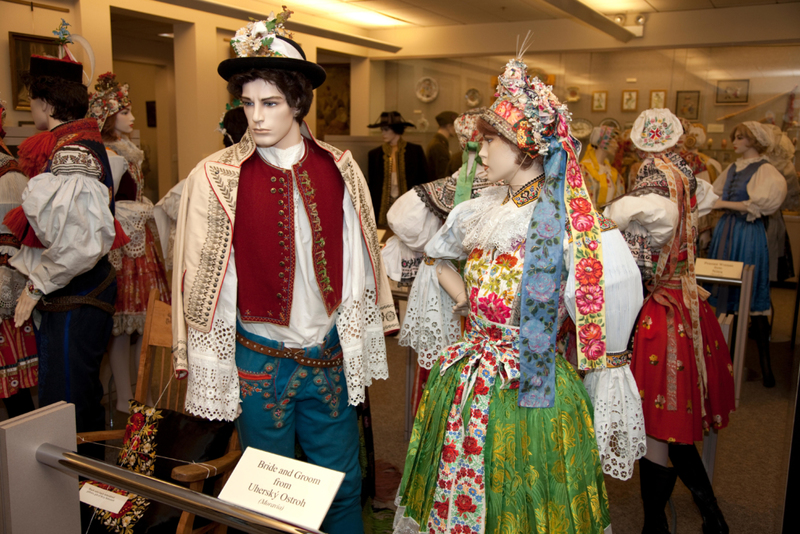
The former Czechoslovakia people are also known as Moravians and some still wear these costumes until today.
Cyprus
The Cypriot island is divided into a Greek part and a Turkish part. While the northern Turkish part is influenced by Turkish traditions, the southern Greek part, is not exactly like the Greek motherland.
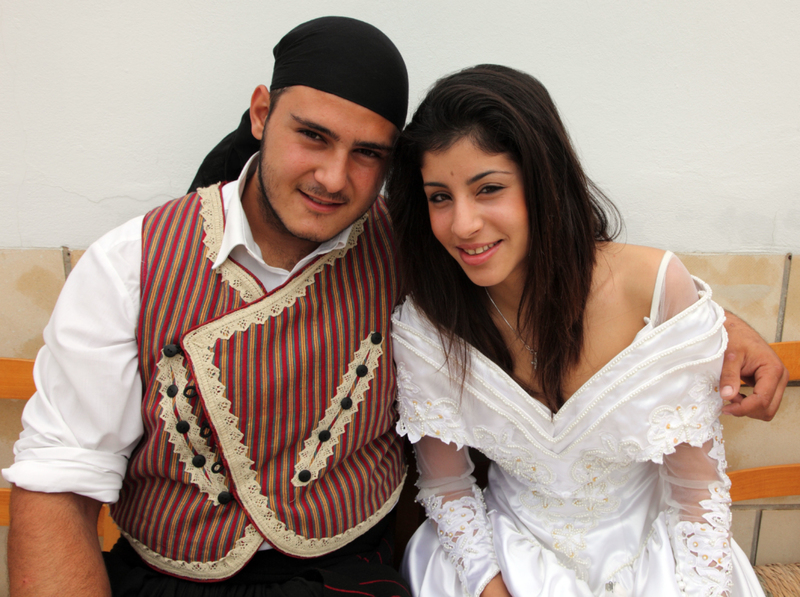
The Cypriot bride wears a white dress, covered in lace. Long gloves adorn her arms, while her groom awaits in classic native dress.
Egypt
Although the Egyptian bride practices Islam, her head is surly covered, but her neck isn't as the Egyptians are more liberal than other Islamic countries. She wears a traditional white dree, the bigger the better.
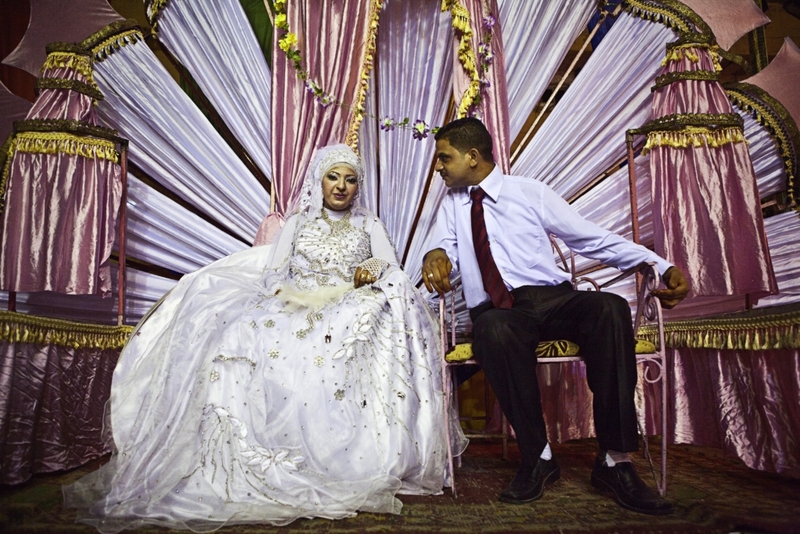
Her dress is covered in gold, to symbolize wealth and richness, and she is adorned with pearls and jewelry.
Taiwan
The Rukai are native Taiwanese. They have traditions that have been passed down for years, including their magnificent wedding traditions. The Rukai bride wears a traditional black tunic with golden embroidery and a red skirt.
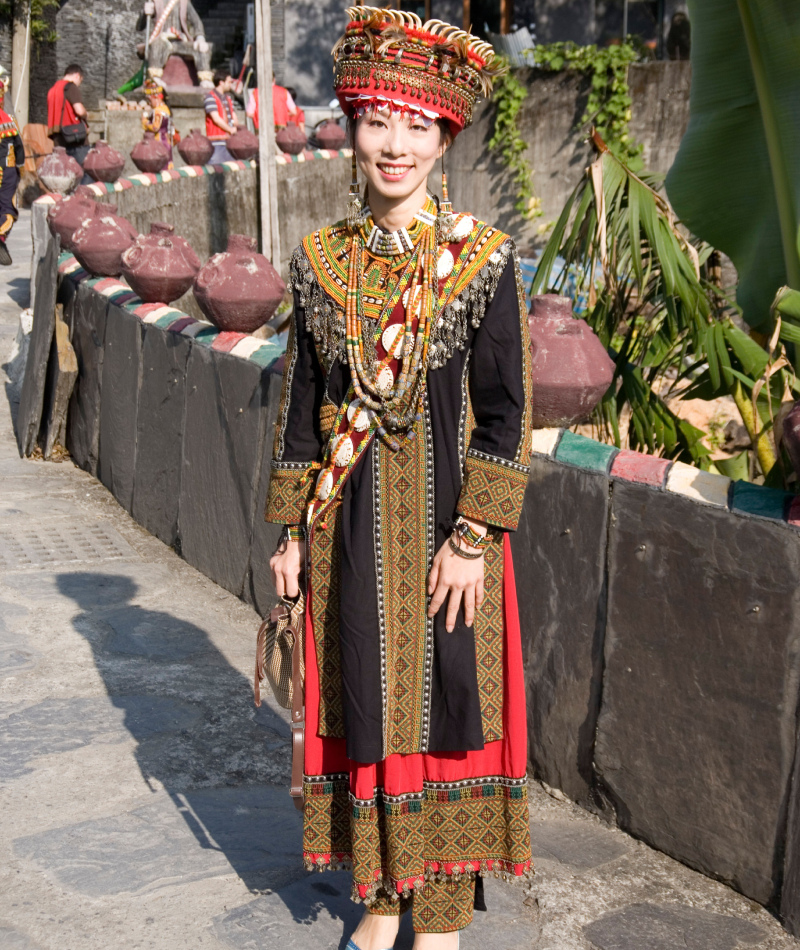
A massive headpiece in matching colors is placed on the bride. The ornaments on the clothing represent the terrible inheritance of the Rukai people.
Inuit
The Inuits cannot afford to wear dainty white wedding dresses. The climate and weather conditions oblige the Inuit bride, to wear her Inuit traditional heavy coat, to ensure she stays warm. There is no other option up north.
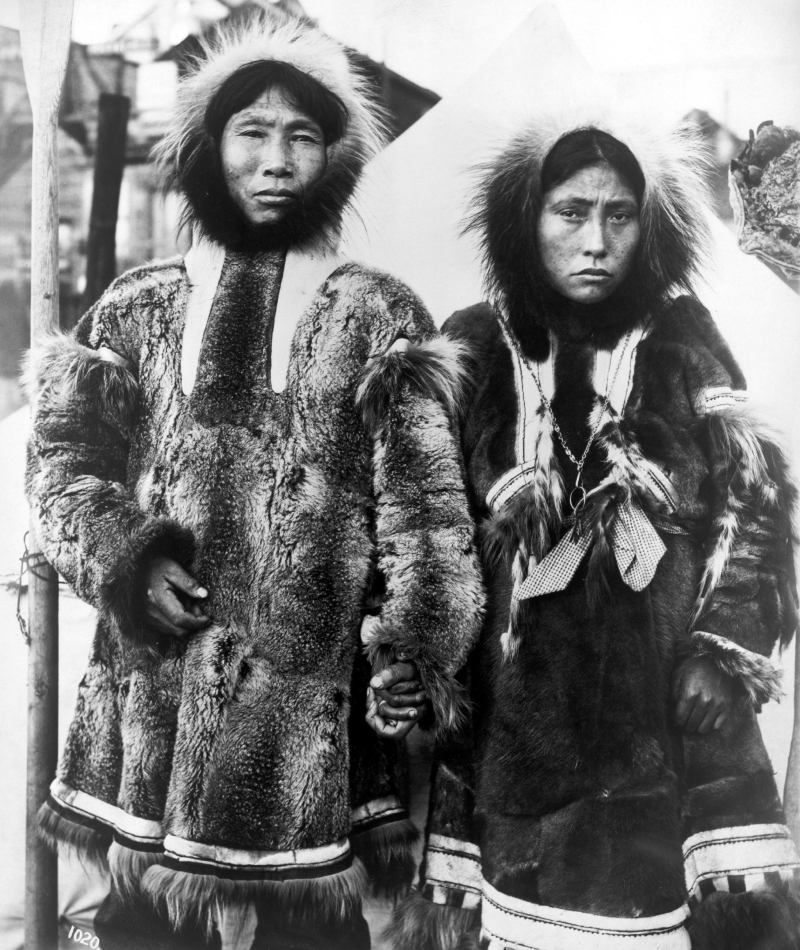
The wedding ceremony in north Greenland or Alaska, where most of the Inuits are found, is relatively a modest ceremony, with drinks, food, and heavy coats.